How to use Serilog in ASP.NET Core 8 MVC application
前言
筆者在前兩篇有針對 "ASP.NET MVC 及 ASP.NET Core MVC 的錯誤處理" 作了描述. 對於錯誤處理(Error Handling) 作了以下定義: 係指錯誤取得 (Catch), 訊息規格 (Specification), 呈現 (Presentation), 及記錄 (Logging).
前兩篇涵蓋了 "錯誤取得" 及 "訊息規格", 尚餘 "呈現" 及 "記錄".
呈現 (Presentation):
需視需求而定. 由於對前端不是很專長, 這裡就先藏拙不表.
記錄 (Logging):
本文主要著重於此. 由於很多人推薦 Serilog, 所以, 就以此作為演練的對象. 一般而言, 記錄會包含以下幾個面向:
- 記錄的層級 (Log Level).
各個 Log 套件都有其 Log Level 的定義, 但大同小異. - 記錄的目標或提供者 (Log Target / Log Provider / Log Sinks).
例如: Console, File, MSSQL, Seq. 前3者很明確, 不作贅述. 至於 Seq 則是一個集中的 Logging 服務 , 它提供了 Web UI 介面, 可以讓開發人員或系統管理人員操作, 進行記錄的查詢.- 在 NLog 稱之為 Targets.
對於 NLog 有興趣的朋友, 可參考這篇文章 NLog Tutorial - The essential guide for logging from C#. - 在 ASP.NET Core build-in Logger 稱之為 Provider.
- 在 Serilog 稱之為 Sinks . 中文很難翻譯, 查 Google 是水槽, 反正就是一個記錄儲存的地方.
- 在 NLog 稱之為 Targets.
- 記錄的內容 (Log Content): 需視需求而定.
本文將以前述 "ASP.NET Core MVC Error Handling 摘要版" 的程式為基底, 繼續往下增修內容.
章節內容如下:
一. 內建 Logger 的功能
二. 加入 Serilog 相關套件
三. 輸出至 Console 及 File 入門
四. 利用 UseSerilogRequestLogging middleware 記錄 Http Request 內容
五. 自訂輸出格式
六. 輸出至 Seq Logging 服務入門
七. 輸出至 MSSQL 資料庫入門
(一) 套件安裝
(二) 由 Serilog.Sinks.MSSqlServer 決定預設的欄位及資料型態 (by appsettings.json)
(三) Serilog.Sinks.MSSqlServer 欄位種類概述
(四) 自訂 Serilog.Sinks.MSSqlServer 的欄位及資料型態 (by Program.cs)
(五) 自訂 Serilog.Sinks.MSSqlServer 的欄位及資料型態 (for ProblemDetails by Program.cs)
(六) 改用自定義的統一輸出格式 (MyProblemDetails)
(七) 建立一層 LoggingService 打包 ILogger, 以利寫入資料庫欄位
八. 關於 Serilog 的增強器 (Enrichers)
範例存放於 GitHub, 有興趣的朋友, 可自行下載參考.
一. 內建 Logger 的功能
1.. 記錄的輸出目標或提供者 (Log Target or Log Provider):
預設會輸出到 Console, 但可以加入 其它輸出, 例如: Debug / Event Log ... 等.
然而經實測, 那個 AddDebug() 似乎沒什麼作用, 按下 [F5] 進行偵錯, 發現記錄內容, 都不會輸出到 [輸出]視窗的[偵錯]項目. 但一般不會用內建的 Logger, 所以就不深究此問題了.
#region 內建 Logger 的設置
// 不寫以下程式, 預設會輸出到 Console.
// 但修改以下的程式, 可以設定更多的輸出目標.
builder.Logging.ClearProviders();
builder.Logging.AddConsole();
builder.Logging.AddDebug();
#endregion
另外, 若有必要, 也可在 Program.cs 取得 logger 物件之後, 呼叫其方法, 輸出 log.
#region 在 Program.cs 使用 Logger
// 建立 logger
var logger = app.Services.GetRequiredService<ILogger<Program>>();
// 使用 logger
logger.LogInformation("Application starting up at {Time}, Environment is {EnvironmentName}", DateTime.Now, app.Environment.EnvironmentName);
#endregion
2.. 記錄類別 (Log Category):
簡單來說, 就是那個 ILogger
private readonly ILogger<HomeController> _logger;
3.. 記錄層級 (Log Level):
Trace = 0, Debug = 1, Information = 2, Warning = 3, Error = 4, Critical = 5, None = 6
以下 appsettings.Development.json 設定檔的內容, 代表:
(1) 如果是 Microsoft.AspNetCore 的記錄類別, 會將 Warning(含) 層級以上的內容, 送至輸出目標.
(2) 其它的記輸出 Information(含) 層級以上的內容至輸出目標.
註: Visual Studio 2022 預設建立的 MVC 專案, 其執行環境為 Development, 所以, 如果在 Visual Studio 2022 執行程式, 要看 appsettings.Development.json 設定檔.
{
"Logging": {
"LogLevel": {
"Default": "Information",
"Microsoft.AspNetCore": "Warning"
}
},
"AllowedHosts": "*"
}
4.. 實測截圖如下.
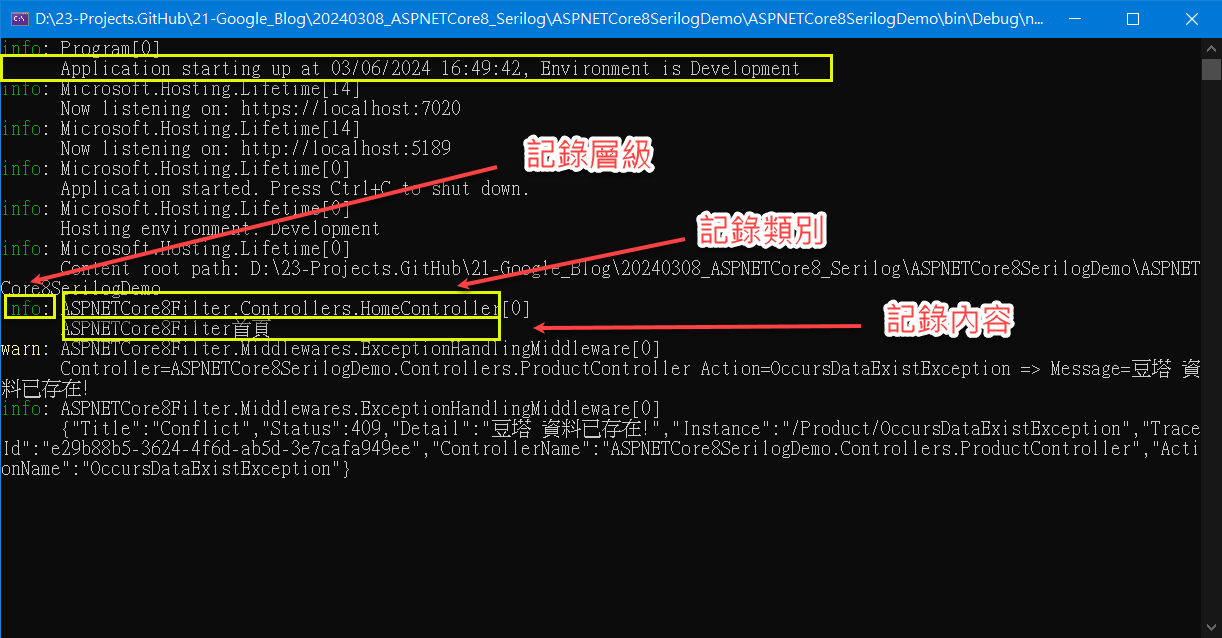
5.. 小結:
以上針對 "內建 Logger 的功能" 作了粗淺的描述, 其實這個只適於自行演練使用, 若為實務上, 通常要寫到 File 或 DB 作為監控之用.
二. 加入 Serilog 相關套件
本段會展示的輸出目標為 Console 及 File.
1.. 各個 Log 套件都有其 Log Level 的定義, 但大同小異.
.NET Core 原生: Trace = 0, Debug = 1, Information = 2, Warning = 3, Error = 4, Critical = 5, None = 6
Serilog: Verbose = 0, Debug = 1, Information = 2, Warning = 3, Error = 4, Fatal = 5
2.. 加入 Serilog.AspNetCore 套件.
目前安裝的是 8.0.1 版, 它會一併安裝其它相依套件.
dotnet add package Serilog.AspNetCore
三. 輸出至 Console 及 File 入門
(一) 程式碼寫死:
1.. 設置 Serilog.
程式碼如下:
using Serilog;
using Serilog.Events;
#region Serilog 的設置及使用
// 設置
Log.Logger = new LoggerConfiguration()
.MinimumLevel.Information()
.MinimumLevel.Override("Microsoft.AspNetCore", LogEventLevel.Warning)
.Enrich.FromLogContext()
.WriteTo.Console()
.WriteTo.File("logs/log-.txt", rollingInterval: RollingInterval.Day)
.CreateLogger();
// 使用
builder.Host.UseSerilog();
#endregion
(1) Log 是一個靜態類別, Logger 是一個靜態屬性(property), 其資料型態為 ILogger 介面.
(2) Log.Logger = new LoggerConfiguration(): 代表開始進行 Logger 的配置.
以下為 Serilog Log 類別的部份原始碼.
public static class Log
{
static ILogger _logger = Serilog.Core.Logger.None;
public static ILogger Logger
{
get => _logger;
set => _logger = Guard.AgainstNull(value);
}
// ~~~~~
}
(3) .MinimumLevel.Information(): 預設最小 Log Level 為 Information. 也就是 >=2 的記錄訊息都會呈現.
(4) .MinimumLevel.Override("Microsoft.AspNetCore", LogEventLevel.Warning): 覆寫 Log Category 為 Microsoft.AspNetCore 的最小 Log Level 為 Warning. 也就是 >=3 的記錄訊息才會呈現.
(5) .Enrich.FromLogContext(): 用以添加 Serilog 當下的運作情境 (context).
請留意: 這個只是告知要加入 LogContext 的欄位, 但預設不會輸出, 要作以下的 {Porperties} 的設定.
Log.Logger = new LoggerConfiguration()
.Enrich.FromLogContext()
.WriteTo.Console(
// {Timestamp:yyyy-MM-dd HH:mm:ss.fff} formats the timestamp.
// {Level:u3} includes the log level (using 3 characters).
// {Message:l} writes the log message.
// {Properties} includes all the properties of the log event.
// {NewLine} starts a new line.
// {Exception} includes the exception details if there is any.
outputTemplate: "{Timestamp:yyyy-MM-dd HH:mm:ss.fff} [{Level:u3}] {Message:l}{NewLine}{Properties}{NewLine}{Exception}"
)
.CreateLogger();
MVC 的 Controller/Action 寫入 log.
_logger.LogInformation("這是 Enrich 首頁");
預計有以下欄位.
"SourceContext": "ASPNETCore8SerilogDemo.Controllers.HomeController",
"ActionId": "9cd447b1-f08a-4fff-b2d3-6e0234f7ba33",
"ActionName": "ASPNETCore8SerilogDemo.Controllers.HomeController.Index (ASPNETCore8SerilogDemo)",
"RequestId": "0HN27N88VEMR7:00000001",
"RequestPath": "/",
"ConnectionId": "0HN27N88VEMR7"
(6) .WriteTo.Console(): 輸出至 Console.
(7) .WriteTo.File("logs/log-.txt", rollingInterval: RollingInterval.Day): 輸出至檔案 (log/log-yyyyMMdd.txt), 每天更換一個記錄檔.
(8) CreateLogger(): 依前述的配置 (LoggerConfiguration), 實際產出一個實作 ILogger 介面的靜態物件.
2.. 使用 Serilog.
透過 IWebHostBuilder 加入 UseSerilog().
builder.Host.UseSerilog();
3.. 小試一下:
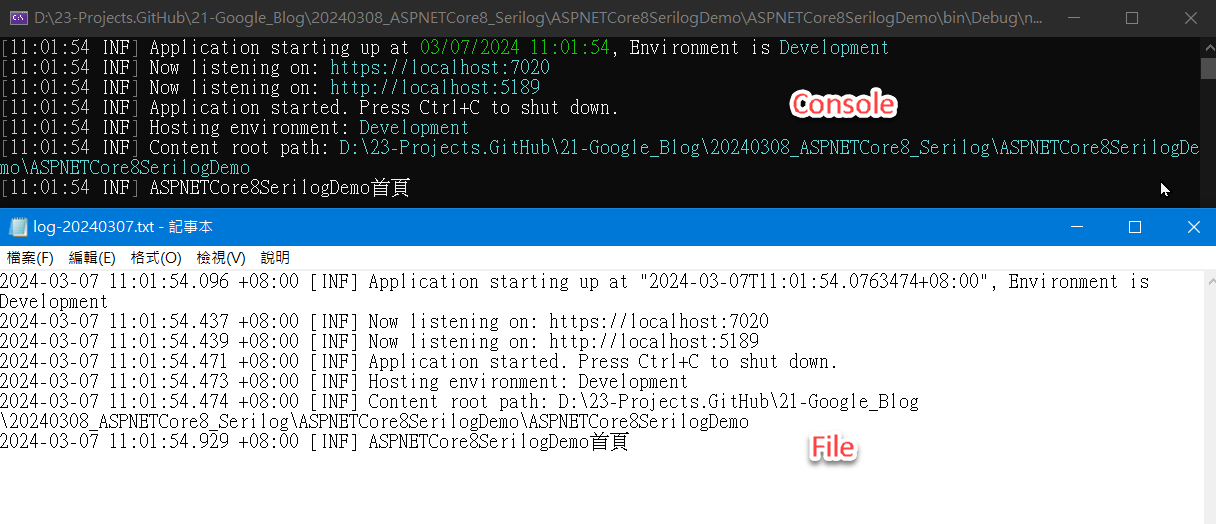
(二) 透過組態檔設置 (appsettings.json or appsettings.*.json)
1.. 修改 appsettings.json.
以下 JSON 的設定與前述程式寫死的效果是相同的.
這裡是用以說明如果採用 JSON 設定檔, 會有那些內容.
註: 請留意 appsettings.json 及 appsettings.*.json 的優先順序. 所以, 這裡直接改 appsettings.json 是改掉最基底的設定.
當然, 若要改在 appsettings.*.json 也是 OK, 只是要注意執行環境.
(1) 在 Development 的環境下, appsettings.json 會被 appsettings.Development.json 覆蓋.
(2) 在 Production 的環境下, appsettings.json 會被 appsettings.Production.json 覆蓋.
{
"Serilog": {
"MinimumLevel": {
"Default": "Information",
"Override": {
"Microsoft.AspNetCore": "Warning"
}
},
"Enrich": [ "FromLogContext" ],
"WriteTo": [
{ "Name": "Console" },
{ "Name": "File", "Args": { "path": "./logs/log-.txt", "rollingInterval": "Day" } }
]
},
"AllowedHosts": "*"
}
2.. 修改程式, 改為讀取 appsetting.json 及 appsettings.*.json.
#region Serilog 的設置及使用
//// 設置: 程式寫死
//Log.Logger = new LoggerConfiguration()
// .MinimumLevel.Information()
// .MinimumLevel.Override("Microsoft.AspNetCore", LogEventLevel.Warning)
// .Enrich.FromLogContext()
// .WriteTo.Console()
// .WriteTo.File("logs/log-.txt", rollingInterval: RollingInterval.Day)
// .CreateLogger();
// 設置: 讀取組態檔 (appsettings.json)
Log.Logger = new LoggerConfiguration()
.ReadFrom.Configuration(builder.Configuration)
.CreateLogger();
builder.Host.UseSerilog();
#endregion
3.. 小試一下:
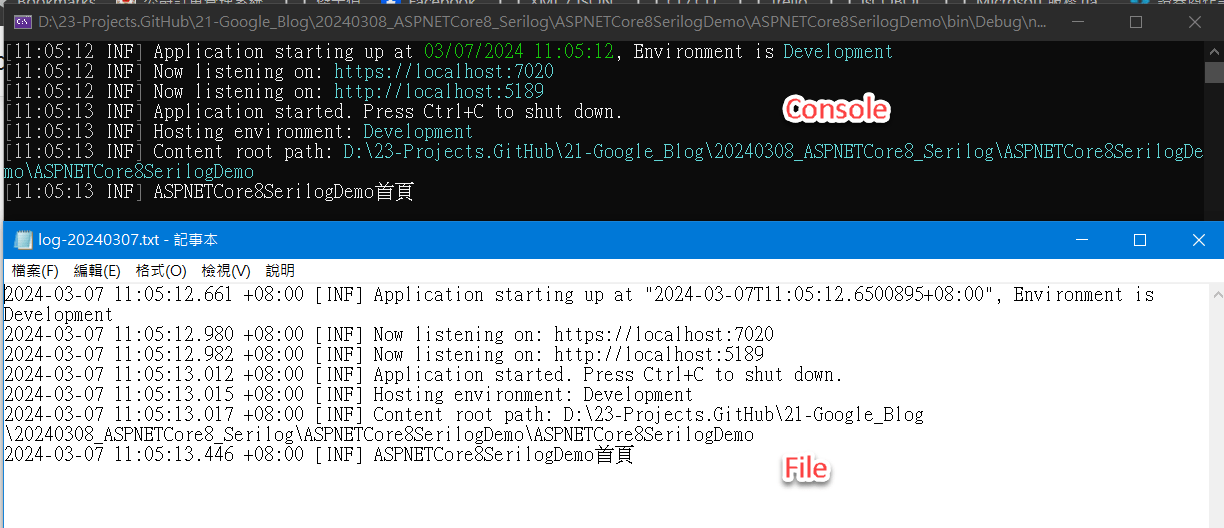
四. 利用 UseSerilogRequestLogging middleware 記錄 Http Request 內容
如果有需要記錄所有 request / response 的一些描述資訊 (meta info) 的話 (例如: RequestMethod, RequestPath, StatusCode, Elapsed, SourceContext, ActionId, ActionName... 等) , 可以採用 UseSerilogRequestLogging 這個 middleware.
1.. 使用 UseSerilogRequestLogging() middleware.
依保哥的文件所述, 這個 Request logging 的紀錄層級為 Information, 要留意. 也就是 Verbose, Debug 記錄層級的內容, 不會被寫入.
app.UseSerilogRequestLogging();
2.. 調整 appsettings.json 的內容.
針對 File 輸出的部份, 改用 Serilog.Formatting.Compact 將記錄內容, 改用 JSON 的格式.
"formatter": "Serilog.Formatting.Compact.CompactJsonFormatter, Serilog.Formatting.Compact"
完整的 appsetting.json 如下:
{
"Serilog": {
"MinimumLevel": {
"Default": "Information",
"Override": {
"Microsoft.AspNetCore": "Warning"
}
},
"Enrich": [ "FromLogContext" ],
"WriteTo": [
{ "Name": "Console" },
{
"Name": "File",
"Args": {
"path": "./logs/log-.txt",
"rollingInterval": "Day",
"formatter": "Serilog.Formatting.Compact.CompactJsonFormatter, Serilog.Formatting.Compact"
}
}
]
},
"AllowedHosts": "*"
}
3.. 小試一下.
(1) 可以看得出來, Console 比較簡要; File 的內容有點亂, 但其實每一列都代表一個 JSON 格式的記錄內容.
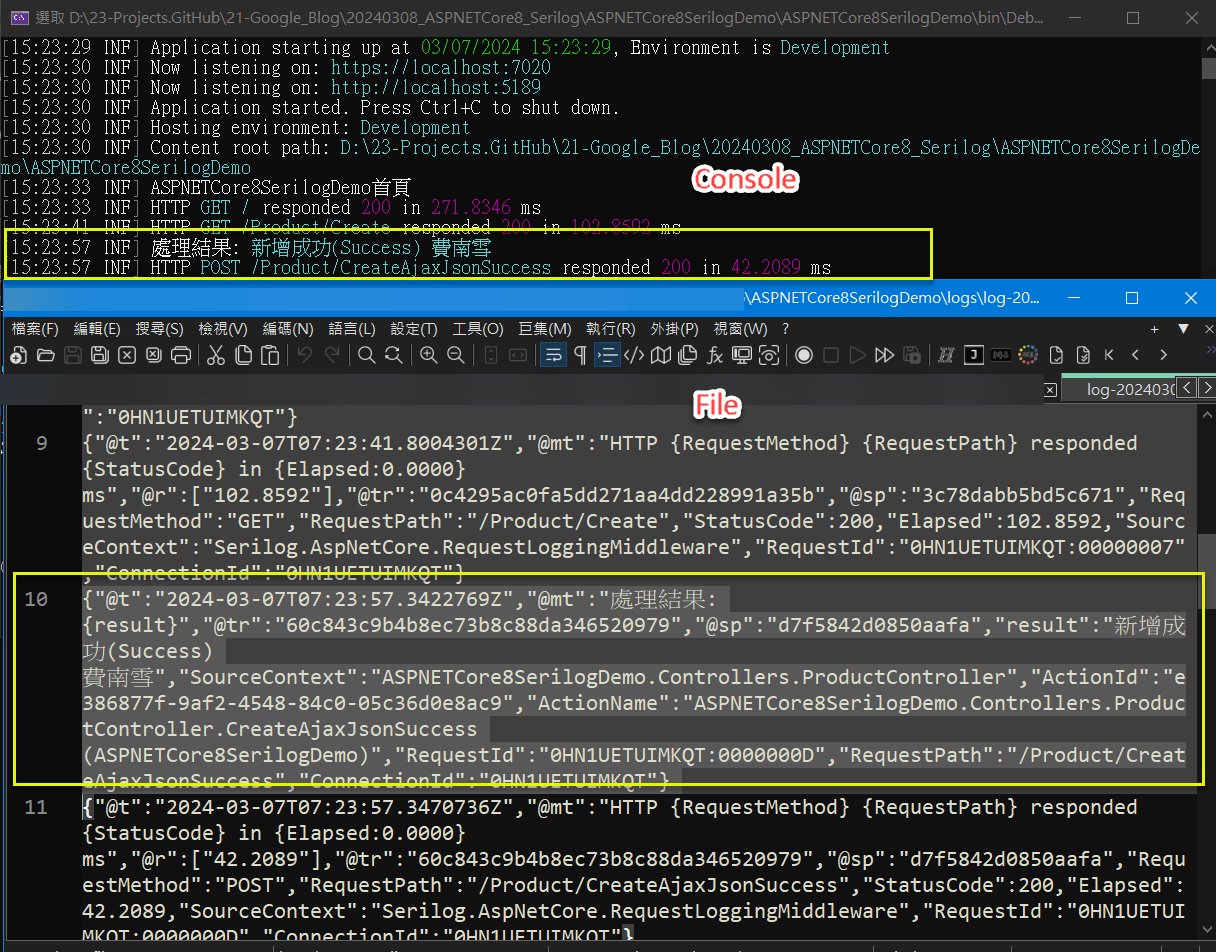
(2) 在 File 各列的 JSON, 可以看到一些以 @ 字元開頭的欄位, 說明如下.
- @t: Time stamp: 時間戳記.
- @mt: Message template: 訊息樣板.
- 如下範例: @mt 就是 "User {UserId} logged in at {LoginTime}", 其中 {UserId}, {LoginTime} 是一個 placeholder (中文翻譯為: 佔位符), 其內容值, 會由 userId, DateTime.Noew 取代.
- 這是結構化日誌記錄中的一個關鍵概念. 訊息的靜態部分和動態部分, 靜態部分保持不變, 而動態部分 (以 { } 含括的那個 placeholder, 會與變數作連結.
Log.Information("User {UserID} logged in at {LoginTime}", userId, DateTime.Now);
- @tr: Trace identifier: HttpContext.TraceIdentifier.
- @sp: Span identifier: Log Scoped Id: 可參考 (Microsoft Learn)Log Scopes, 本文不多作說明.
- @l: Log Level.
- @x: Exception.
完整的清單, 可以參考這篇 (GitHub) Serilog Expressions / Language Reference
(3) 經 Json Grid 處理後呈現, 看起來就明顯多了.
(4) 以下是由 ~/Home/Index 頁面操作, 取得的 Log 內容.
public IActionResult Index()
{
_logger.LogInformation("ASPNETCore8SerilogDemo首頁");
return View();
}
{
"@t": "2024-03-07T07:23:33.3291331Z",
"@mt": "ASPNETCore8SerilogDemo首頁",
"@tr": "1d220f74bb230ff942745fcf3a352bf7",
"@sp": "d70f8980425a20e3",
"SourceContext": "ASPNETCore8SerilogDemo.Controllers.HomeController",
"ActionId": "4ed0f57f-084f-4a2d-a98d-44c8b0d8e941",
"ActionName": "ASPNETCore8SerilogDemo.Controllers.HomeController.Index (ASPNETCore8SerilogDemo)",
"RequestId": "0HN1UETUIMKQT:00000001",
"RequestPath": "/",
"ConnectionId": "0HN1UETUIMKQT"
}

(5) 以下是由 ~/Product/Create 頁面操作, 取得的 Log 內容.
- 第10列: (發生 2XX 成功)
[HttpPost]
public IActionResult CreateAjaxJsonSuccess([FromBody] ProductViewModel product)
{
var result = $"新增成功(Success) {product.Name}";
_logger.LogInformation("處理結果: {result}", result);
return Json(new { Result = result });
}
{
"@t": "2024-03-07T07:23:57.3422769Z",
"@mt": "處理結果: {result}",
"@tr": "60c843c9b4b8ec73b8c88da346520979",
"@sp": "d7f5842d0850aafa",
"result": "新增成功(Success) 費南雪",
"SourceContext": "ASPNETCore8SerilogDemo.Controllers.ProductController",
"ActionId": "e386877f-9af2-4548-84c0-05c36d0e8ac9",
"ActionName": "ASPNETCore8SerilogDemo.Controllers.ProductController.CreateAjaxJsonSuccess (ASPNETCore8SerilogDemo)",
"RequestId": "0HN1UETUIMKQT:0000000D",
"RequestPath": "/Product/CreateAjaxJsonSuccess",
"ConnectionId": "0HN1UETUIMKQT"
}
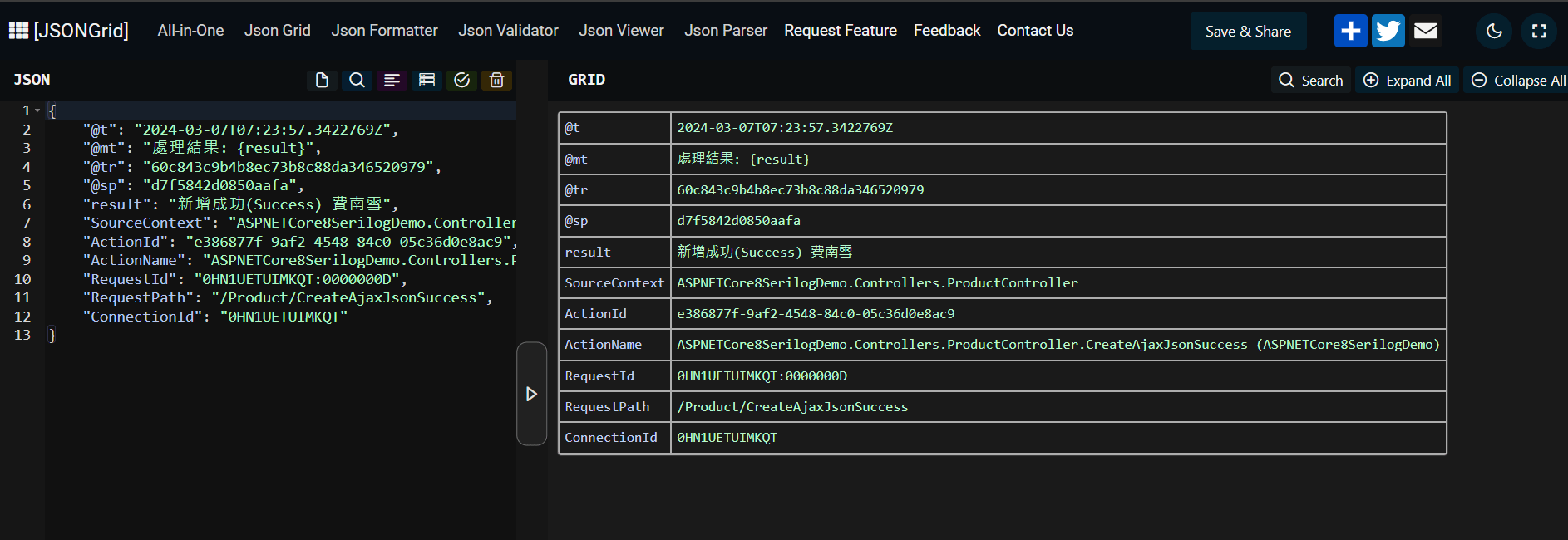
- 第12列: (發生 4XX 警告)
[HttpPost]
public IActionResult OccursOutRangeException([FromBody] ProductViewModel product)
{
var result = _service.OccursOutRangeException(product);
return Json(new { Result = result });
}
{
"@t": "2024-03-07T07:24:02.1738471Z",
"@mt": "Controller={controllerName} Action={actionName} => Message={message}",
"@l": "Warning",
"@tr": "2f62147fb52b9aead7593bc1ee4abce5",
"@sp": "4dc793df4cb40a19",
"controllerName": "ASPNETCore8SerilogDemo.Controllers.ProductController",
"actionName": "OccursOutRangeException",
"message": "產品單價 超出範圍!",
"SourceContext": "ASPNETCore8Filter.Middlewares.ExceptionHandlingMiddleware",
"RequestId": "0HN1UETUIMKQT:0000000F",
"RequestPath": "/Product/OccursOutRangeException",
"ConnectionId": "0HN1UETUIMKQT"
}
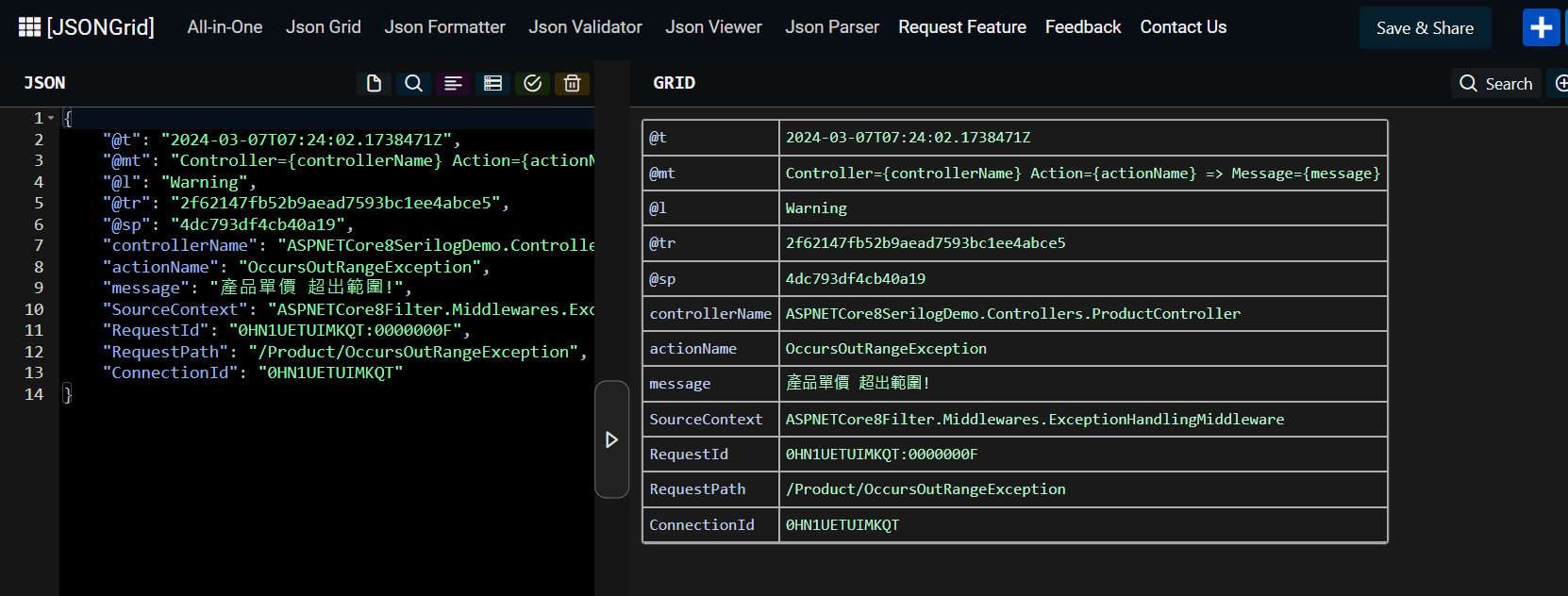
- 第15列: (發生 5XX 錯誤)
[HttpPost]
public IActionResult OccursIOException([FromBody] ProductViewModel product)
{
throw new System.IO.IOException("費南雪武功密笈 不存在");
}
{
"@t": "2024-03-07T07:24:03.9677882Z",
"@mt": "Controller={controllerName} Action={actionName} => Message={message}",
"@l": "Error",
"@x": "System.IO.IOException: 費南雪武功密笈 不存在\r\n at ASPNETCore8SerilogDemo.Controllers.ProductController.OccursIOException(ProductViewModel product) in D:\\23-Projects.GitHub\\21-Google_Blog\\20240308_ASPNETCore8_Serilog\\ASPNETCore8SerilogDemo\\ASPNETCore8SerilogDemo\\Controllers\\ProductController.cs:line 124\r\n at lambda_method42(Closure, Object, Object[])\r\n at Microsoft.AspNetCore.Mvc.Infrastructure.ActionMethodExecutor.SyncActionResultExecutor.Execute(ActionContext actionContext, IActionResultTypeMapper mapper, ObjectMethodExecutor executor, Object controller, Object[] arguments)\r\n at Microsoft.AspNetCore.Mvc.Infrastructure.ControllerActionInvoker.InvokeActionMethodAsync()\r\n at Microsoft.AspNetCore.Mvc.Infrastructure.ControllerActionInvoker.Next(State& next, Scope& scope, Object& state, Boolean& isCompleted)\r\n at Microsoft.AspNetCore.Mvc.Infrastructure.ControllerActionInvoker.InvokeNextActionFilterAsync()\r\n--- End of stack trace from previous location ---\r\n at Microsoft.AspNetCore.Mvc.Infrastructure.ControllerActionInvoker.Rethrow(ActionExecutedContextSealed context)\r\n at Microsoft.AspNetCore.Mvc.Infrastructure.ControllerActionInvoker.Next(State& next, Scope& scope, Object& state, Boolean& isCompleted)\r\n at Microsoft.AspNetCore.Mvc.Infrastructure.ControllerActionInvoker.InvokeInnerFilterAsync()\r\n--- End of stack trace from previous location ---\r\n at Microsoft.AspNetCore.Mvc.Infrastructure.ResourceInvoker.<InvokeNextResourceFilter>g__Awaited|25_0(ResourceInvoker invoker, Task lastTask, State next, Scope scope, Object state, Boolean isCompleted)\r\n at Microsoft.AspNetCore.Mvc.Infrastructure.ResourceInvoker.Rethrow(ResourceExecutedContextSealed context)\r\n at Microsoft.AspNetCore.Mvc.Infrastructure.ResourceInvoker.Next(State& next, Scope& scope, Object& state, Boolean& isCompleted)\r\n at Microsoft.AspNetCore.Mvc.Infrastructure.ResourceInvoker.InvokeFilterPipelineAsync()\r\n--- End of stack trace from previous location ---\r\n at Microsoft.AspNetCore.Mvc.Infrastructure.ResourceInvoker.<InvokeAsync>g__Awaited|17_0(ResourceInvoker invoker, Task task, IDisposable scope)\r\n at Microsoft.AspNetCore.Mvc.Infrastructure.ResourceInvoker.<InvokeAsync>g__Awaited|17_0(ResourceInvoker invoker, Task task, IDisposable scope)\r\n at Microsoft.AspNetCore.Authorization.AuthorizationMiddleware.Invoke(HttpContext context)\r\n at ASPNETCore8Filter.Middlewares.ExceptionHandlingMiddleware.InvokeAsync(HttpContext context) in D:\\23-Projects.GitHub\\21-Google_Blog\\20240308_ASPNETCore8_Serilog\\ASPNETCore8SerilogDemo\\ASPNETCore8Filter\\Middlewares\\ExceptionHandlingMiddleware.cs:line 42",
"@tr": "2c74038eb32ea071d26b0f688f0173ba",
"@sp": "726294b6d80782cd",
"controllerName": "ASPNETCore8SerilogDemo.Controllers.ProductController",
"actionName": "OccursIOException",
"message": "費南雪武功密笈 不存在",
"SourceContext": "ASPNETCore8Filter.Middlewares.ExceptionHandlingMiddleware",
"RequestId": "0HN1UETUIMKQT:00000011",
"RequestPath": "/Product/OccursIOException",
"ConnectionId": "0HN1UETUIMKQT"
}
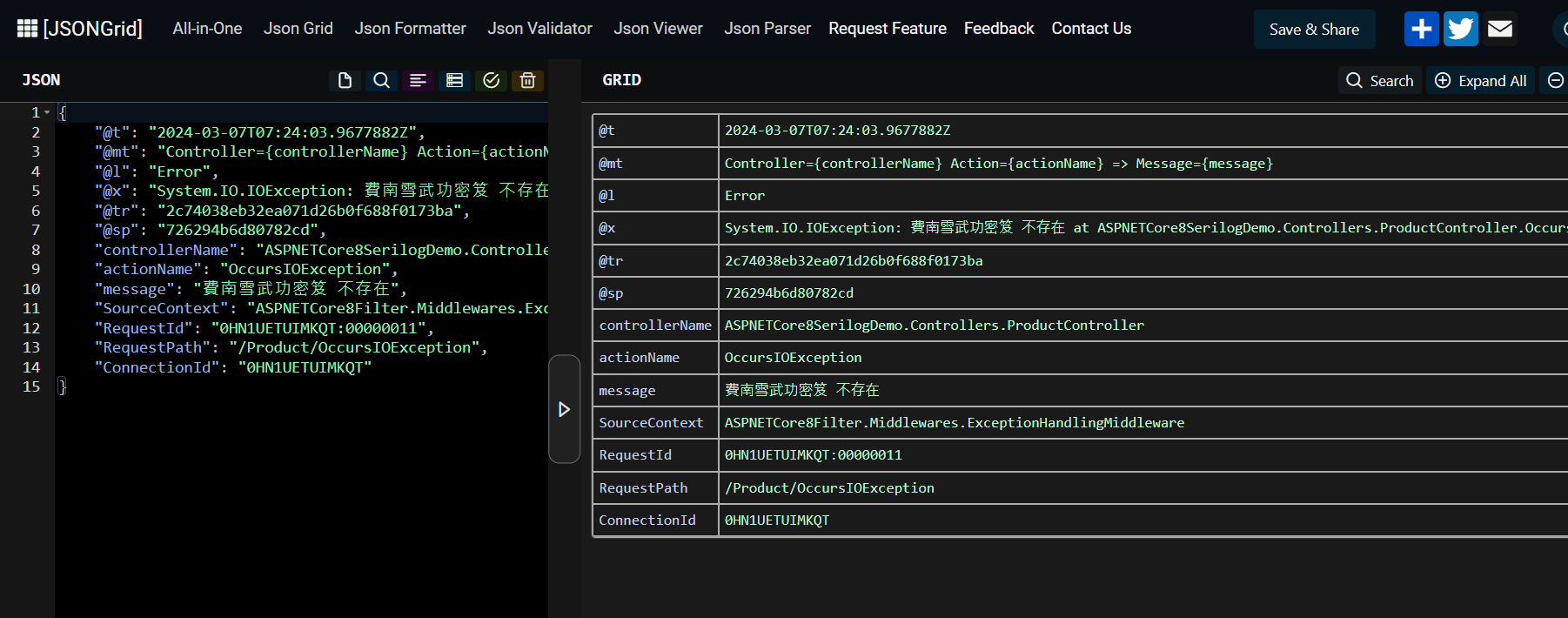
(6) UseSerilogRequestLogging middleware 會額外加上一些它自己本身的訊息輸出. 例如:
{
"@t": "2024-03-07T07:23:33.5531548Z",
"@mt": "HTTP {RequestMethod} {RequestPath} responded {StatusCode} in {Elapsed:0.0000} ms",
"@r": [
"271.8346"
],
"@tr": "1d220f74bb230ff942745fcf3a352bf7",
"@sp": "d70f8980425a20e3",
"RequestMethod": "GET",
"RequestPath": "/",
"StatusCode": 200,
"Elapsed": 271.8346,
"SourceContext": "Serilog.AspNetCore.RequestLoggingMiddleware",
"RequestId": "0HN1UETUIMKQT:00000001",
"ConnectionId": "0HN1UETUIMKQT"
}
@r: renderings: 如果訊息樣板包含 .NET-specific 樣式 ( {Elapsed:0.0000} ), 則 @r 會是一個陣列, 逐一與訊息樣板作對應.
而在 Console 就只會出現以下的內容.
[15:23:33 INF] HTTP GET / responded 200 in 271.8346 ms
4.. 小結:
除了應用程式輸出的 Log 之外, UseSerilogRequestLogging middleware 也會補上自己產出的訊息.
五. 自訂輸出格式
由於預設的輸出格式, 可能不符需求, 需要自訂. 可以參考 (GitHub) Formatting Output 的說明. 該文亦有針對 JSON 作一些格式化的說明.
- Exception: 完整的例外訊息. 若沒例外物件的話, 會是 Empty.
- Level: Log Level, 預設為完整的 Log Level 名稱. 可以加一些修飾, 成為 3 個字元, 例如: {Level:u3} 全大寫, {Level:w3} 全小寫.
- Message: Log Message, 預設為純文字. 可以加一些修飾, 例如: {Message:l}-移除單引號或雙引號 {Message:j}-採用 json 格式輸出.
- NewLine: 即 System.Environment.NewLine.
- Properties: 輸出中其他未出現的所有事件屬性值. 使用 {Properties:j} 代表輸出為 json 格式.
- Timestamp: 事件的時間戳記, 為 DateTimeOffset.
- TraceId: HttpContext.TradeIdentity.
- SpanId: Scoped Id.
以下僅就 Console 的輸出, 作了一個.
- {Message} 的效果
2024-03-08 11:52:58.787 [INF] Application starting up at 03/08/2024 11:52:58, Environment is "Development"
2024-03-08 11:52:59.091 [INF] Now listening on: "https://localhost:7020"
2024-03-08 11:52:59.095 [INF] Now listening on: "http://localhost:5189"
2024-03-08 11:52:59.117 [INF] Application started. Press Ctrl+C to shut down.
2024-03-08 11:52:59.119 [INF] Hosting environment: "Development"
2024-03-08 11:52:59.122 [INF] Content root path: "D:\\23-Projects.GitHub\\21-Google_Blog\\20240308_ASPNETCore8_Serilog\\ASPNETCore8SerilogDemo\\ASPNETCore8SerilogDemo"
2024-03-08 11:52:59.632 [INF] HTTP "GET" "/Product/Create" responded 200 in 132.1355 ms
2024-03-08 11:53:03.237 [INF] ASPNETCore8Filter首頁
2024-03-08 11:53:03.249 [INF] HTTP "GET" "/ASPNETCore8Filter/Home/Index" responded 200 in 14.2502 ms
2024-03-08 11:53:04.958 [INF] HTTP "GET" "/Product/Create" responded 200 in 12.8478 ms
2024-03-08 11:53:07.295 [WRN] Controller="ASPNETCore8SerilogDemo.Controllers.ProductController" Action="OccursDataNotExistException" => Message="費南雪 資料不存在!"
2024-03-08 11:53:07.299 [INF] "{\"Title\":\"NotFound\",\"Status\":404,\"Detail\":\"費南雪 資料不存在!\",\"Instance\":\"/Product/OccursDataNotExistException\",\"TraceId\":\"70e87fbe-ba37-40f0-9e8a-58e8f4f8d6e2\",\"ControllerName\":\"ASPNETCore8SerilogDemo.Controllers.ProductController\",\"ActionName\":\"OccursDataNotExistException\"}"
2024-03-08 11:53:07.304 [INF] HTTP "POST" "/Product/OccursDataNotExistException" responded 404 in 45.5716 ms
- {Message:l} 的效果: 把多餘的雙引號移掉, 看來似乎有比較清爽.
2024-03-08 11:53:48.174 [INF] Application starting up at 03/08/2024 11:53:48, Environment is Development
2024-03-08 11:53:48.498 [INF] Now listening on: https://localhost:7020
2024-03-08 11:53:48.501 [INF] Now listening on: http://localhost:5189
2024-03-08 11:53:48.524 [INF] Application started. Press Ctrl+C to shut down.
2024-03-08 11:53:48.526 [INF] Hosting environment: Development
2024-03-08 11:53:48.528 [INF] Content root path: D:\23-Projects.GitHub\21-Google_Blog\20240308_ASPNETCore8_Serilog\ASPNETCore8SerilogDemo\ASPNETCore8SerilogDemo
2024-03-08 11:53:49.067 [INF] HTTP GET /Product/Create responded 200 in 149.6317 ms
2024-03-08 11:53:56.832 [INF] ASPNETCore8Filter首頁
2024-03-08 11:53:56.843 [INF] HTTP GET /ASPNETCore8Filter/Home/Index responded 200 in 13.8720 ms
2024-03-08 11:53:58.028 [INF] HTTP GET /Product/Create responded 200 in 5.5163 ms
2024-03-08 11:54:07.017 [WRN] Controller=ASPNETCore8SerilogDemo.Controllers.ProductController Action=OccursDataNotExistException => Message=費南雪 資料不存在!
2024-03-08 11:54:07.021 [INF] {"Title":"NotFound","Status":404,"Detail":"費南雪 資料不存在!","Instance":"/Product/OccursDataNotExistException","TraceId":"4d279475-a886-4e3d-b3b4-f8073aa3274d","ControllerName":"ASPNETCore8SerilogDemo.Controllers.ProductController","ActionName":"OccursDataNotExistException"}
2024-03-08 11:54:07.022 [INF] HTTP POST /Product/OccursDataNotExistException responded 404 in 35.1407 ms
六. 輸出至 Seq Logging 服務入門
Seq 是一個集中的 Logging 服務 , 它提供了 Web UI 介面, 可以讓開發人員或系統管理人員操作, 進行記錄的查詢. 請留意, 這個不適合開放給使用者查詢!
Seq 提供了 2 種執行方式: (1) 自行在 Windows Server 安裝, (2) 下載並執行基於 Linux 的 docker image. 本文採用 docker 的方式執行.
1.. 修改程式: 加入對 Seq 的輸出.
(1) nuget Serilog.Sinks.Seq (目前為 7.0.0 版).
(2) 調整 Program.cs.
加入 .WriteTo.Seq("http://localhost:5341") 程式段.
// 設置: 讀取組態檔 (appsettings.json)
Log.Logger = new LoggerConfiguration()
.ReadFrom.Configuration(builder.Configuration)
.WriteTo.Seq("http://localhost:5341")
.CreateLogger();
builder.Host.UseSerilog();
註: 在 nuget manager 出現了 "您安裝了 3 個有弱點的套件" 的訊息, 經查, 都是 Nuget 6.3.1, 所以, 改升級至 6.8.1. 不然, 看到那些警告, 就很討厭.
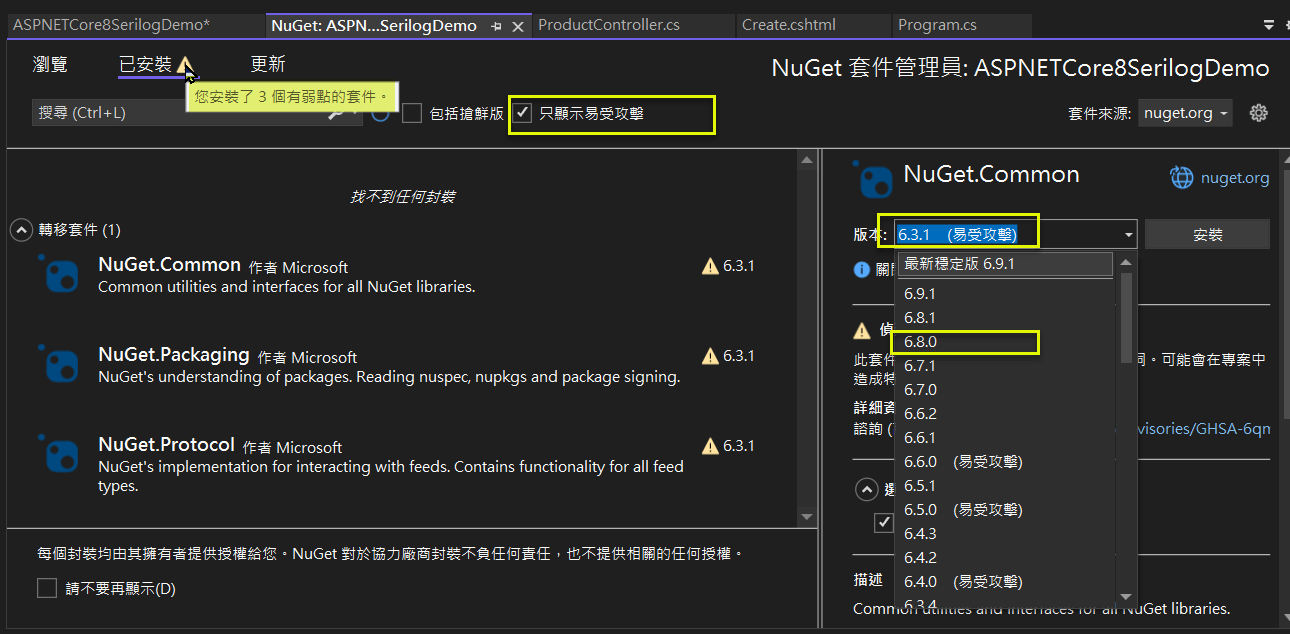
(3) 調整 ExceptionHandlingMiddleware.cs.
加入輸出結構化資料的 LogRequest() 程式段, 重要: Seq Logging Service UI 可以支援 結構化資料 的查詢.
public async Task InvokeAsync(HttpContext context)
{
try
{
LogRequest(context);
await _next(context);
}
catch (Exception ex)
{
await HandleExceptionAsync(context, ex);
}
}
private void LogRequest(HttpContext context)
{
// STEP 1: 取得 trace id / controller name / action name
var traceId = context.TraceIdentifier;
string? controllerName = null;
string? actionName = null;
var endpoint = context.GetEndpoint();
if (endpoint != null)
{
var actionDescriptor = endpoint.Metadata.GetMetadata<ControllerActionDescriptor>();
if (actionDescriptor != null)
{
controllerName = actionDescriptor.ControllerTypeInfo.FullName;
actionName = actionDescriptor.ActionName;
}
}
// 結構化輸出
_logger.LogInformation("TraceId={TraceId}, ControllerName={ControllerName}, ActionName={ActionName}",
traceId, controllerName, actionName);
}
2.. 執行 docker desktop for windows.
3.. 執行 docker 指令, 以運行 Seq Logging Service.
docker run --name seq -d --restart unless-stopped -e ACCEPT_EULA=Y -p 5341:80 datalust/seq:latest
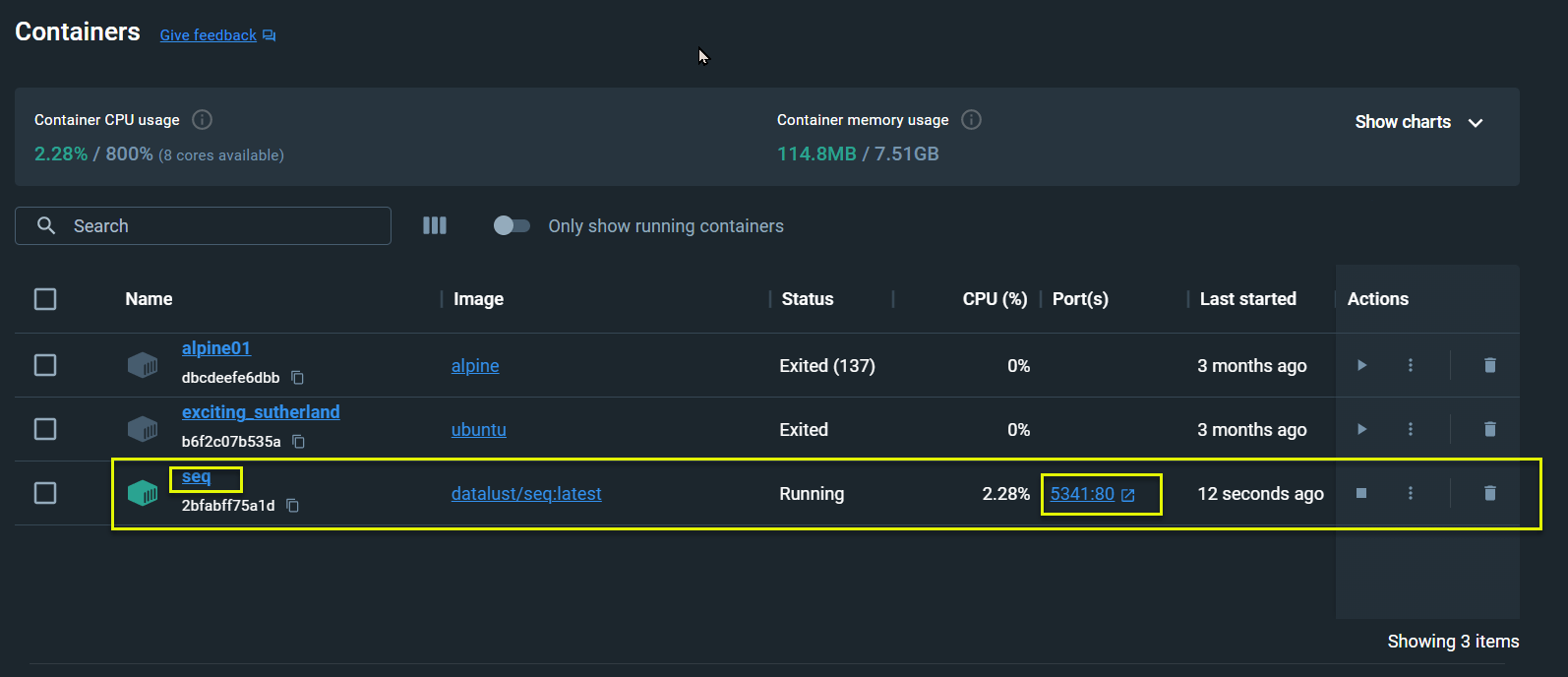
4.. 打開 Chrome / Edge ... 等瀏覽器, 輸入 http://localhost:5341

5.. 執行 ASPNETCore8SerilogDemo 程式. 會發現 Console 有記錄輸出, 但 Seq 似乎沒有動靜. 此時, 請按下 [Go], 如圖.
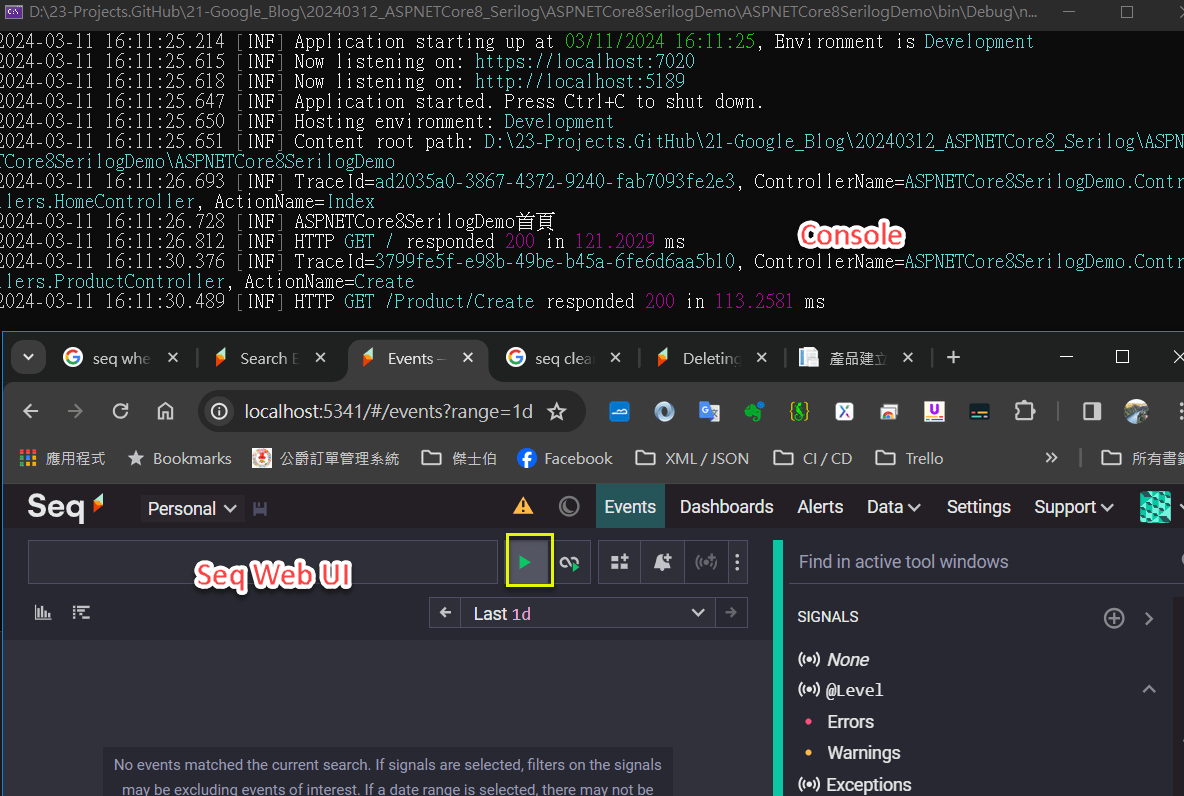
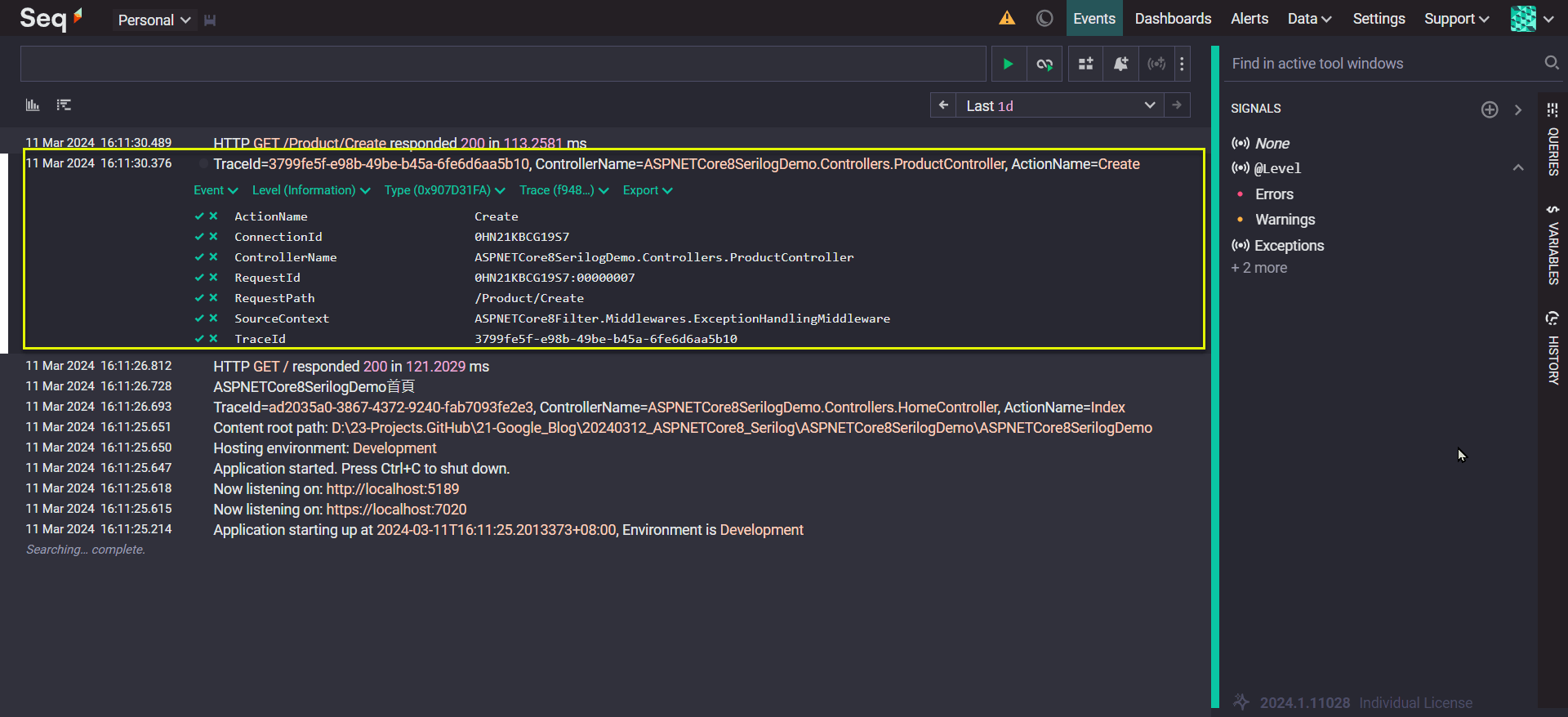
上圖的黃框, 其實是一些 Properties, 其中 TraceId, ControllerName, ActionName 就是前述樣版格式化輸出的欄位. 這個有什麼用呢? Seq 有一個很強的功能, 可以將所有的 Log 資料, 以 樣版格式化輸出的欄位, 作為查詢的條件. 例如:
- ControllerName="ASPNETCore8SerilogDemo.Controllers.ProductController"
- ControllerName like "%.Product%"

詳細的 Seq 查詢語法, 可參考 Seq 官方文件的 Search Expression Syntax
6.. 如果 Log 資料太多, 可以刪掉.
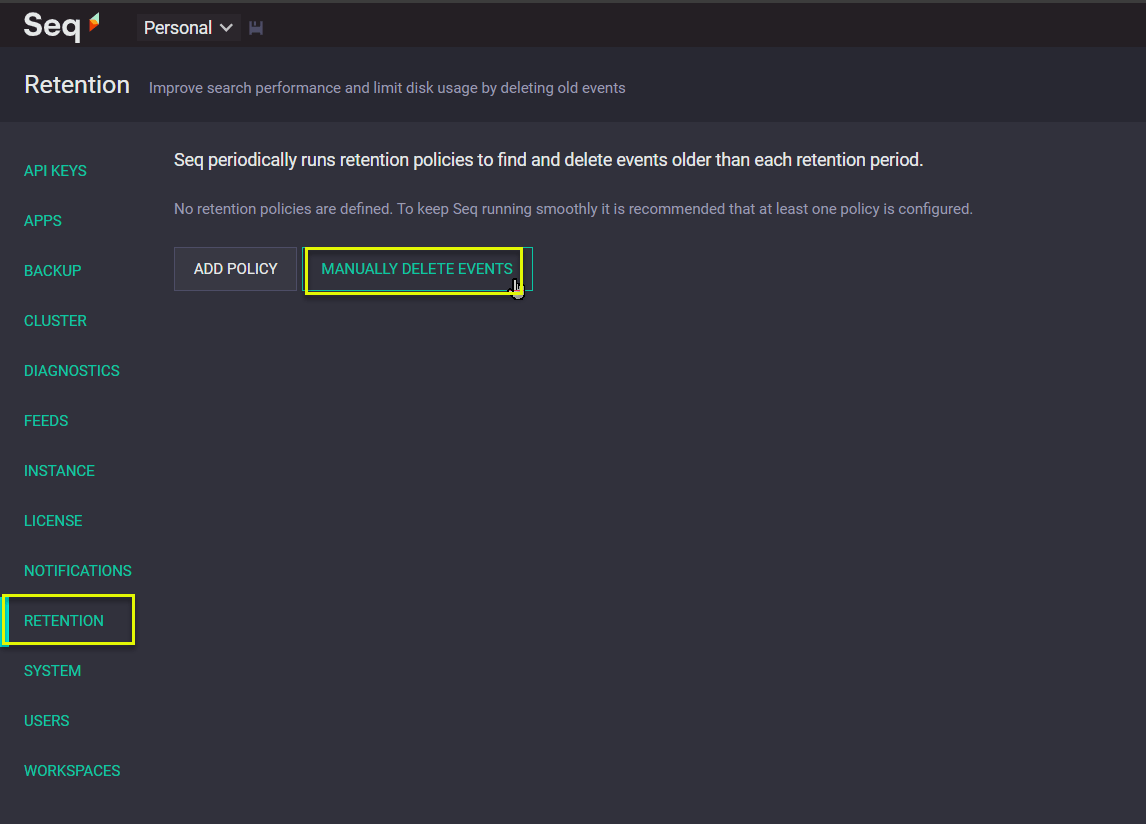
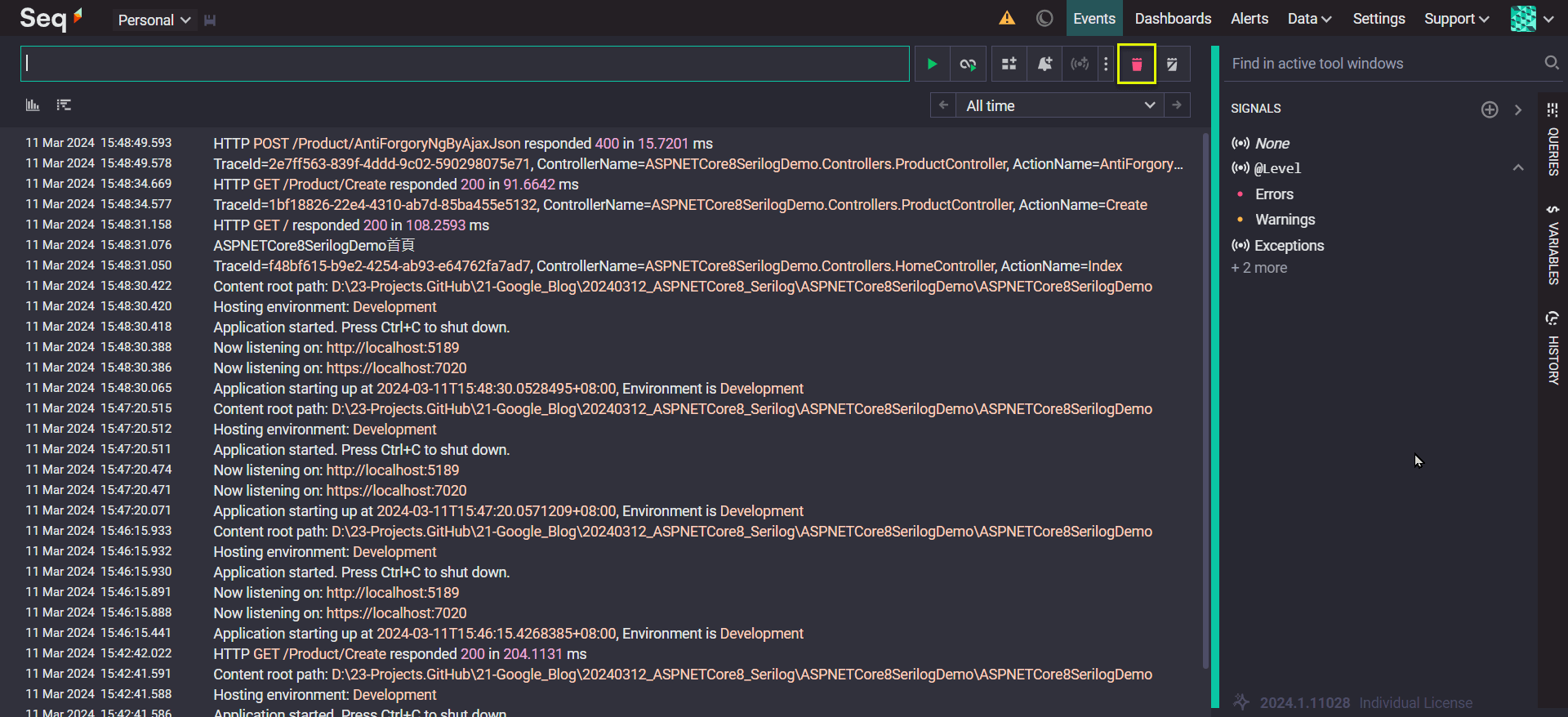
7.. 使用 Serilog 訊息樣板提供的物件解構子 功能
Seq 提供物件解構子的功能, 在訊息樣板採用 {@placeHolder}, 即可將對應的物件, 轉成多個 placeHolder.
(1) 官網的入門範例.
關於 placeHolder 的說明, 可以 參考這篇的例子. 有 @ 前置的話, 會將傳入的物作序列化; 沒有 @ 前置的話, 就直接採用 ToString().
var position = new { Latitude = 25, Longitude = 134 };
var elapsedMs = 34;
log.Information("Processed {@Position} in {Elapsed} ms", position, elapsedMs);
(2) 修改 ExceptionHandlingMiddleware.cs
重點在以下 2 個程式段:
- _logger.LogWarning("警告 {@result}", result);
- _logger.LogError(exception, "錯誤: {@result}", result);
{@result}, result 會被展開為:
- "{result.Status} {result.Ttile} {result.Detail} ... {result.TraceId}", result.Status, result.Title, result.Detail, ... result.TraceId
請留意: 以下是把 response變數(ProblemDetails物件), 重整為 "匿名物件" (anynymous) 後作輸出; 與後續提到的直接輸出 response變數內容, 有一些差異.
#region 原始的作法
//string jsonString = JsonSerializer.Serialize(response, _jsonOptions);
//if (response.Status >= 400 && response.Status < 500)
// _logger.LogWarning("Controller={controllerName} Action={actionName} => Message={message}", controllerName, actionName, exception.Message);
//if (response.Status >= 500)
// _logger.LogError(exception, "Controller={controllerName} Action={actionName} => Message={message}", controllerName, actionName, exception.Message);
//_logger.LogInformation("{json}", jsonString); //輸出完整的 json 字串
#endregion
#region 針對 Serilog 作結構化輸出 (@解構子)
var result = new
{
Status = response.Status,
Title = response.Title,
Detail = response.Detail,
Instance = response.Instance,
ControllerName = controllerName,
ActionName = actionName,
TraceId = traceId
};
#endregion
if (response.Status >= 400 && response.Status < 500)
_logger.LogWarning("警告 {@result}", result);
if (response.Status >= 500)
_logger.LogError(exception, "錯誤: {@result}", result);
(3) 看一下 Console 的輸出結果.
第1個黃框對應的是: _logger.LogWarning("警告 {@result}", result);
第2個黃框及第1個紅框對應的是: _logger.LogError(exception, "錯誤: {@result}", result);
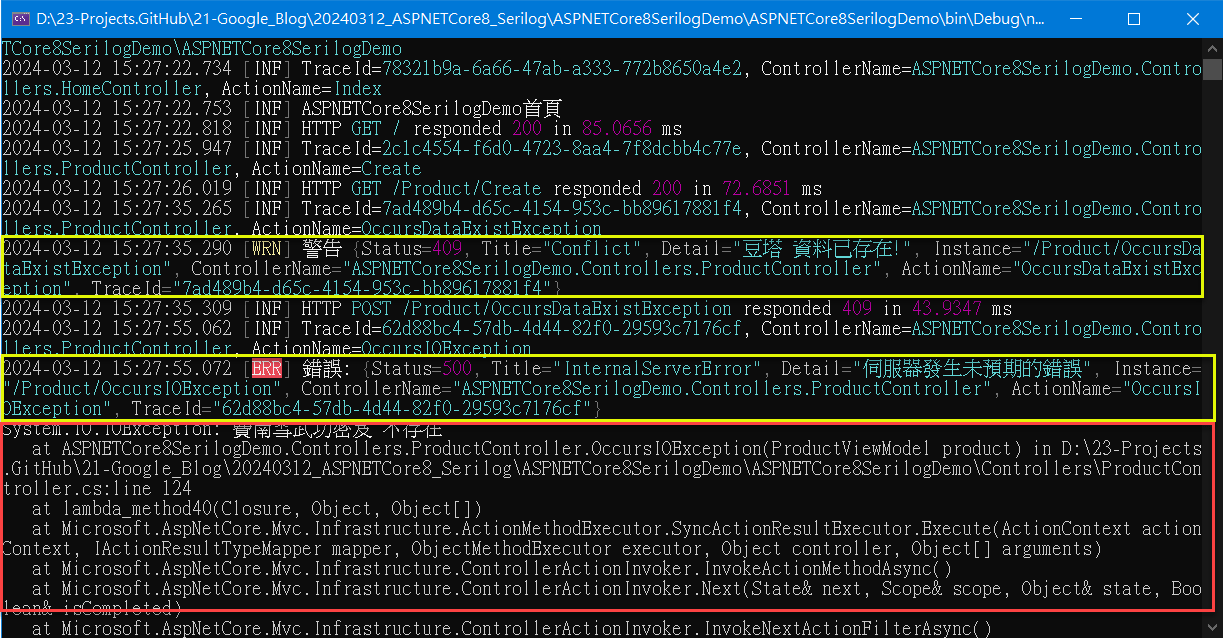
(4) 看一下 Seq 的輸出結果.
下圖是 _logger.LogWarning("警告 {@result}", result); 的結果.
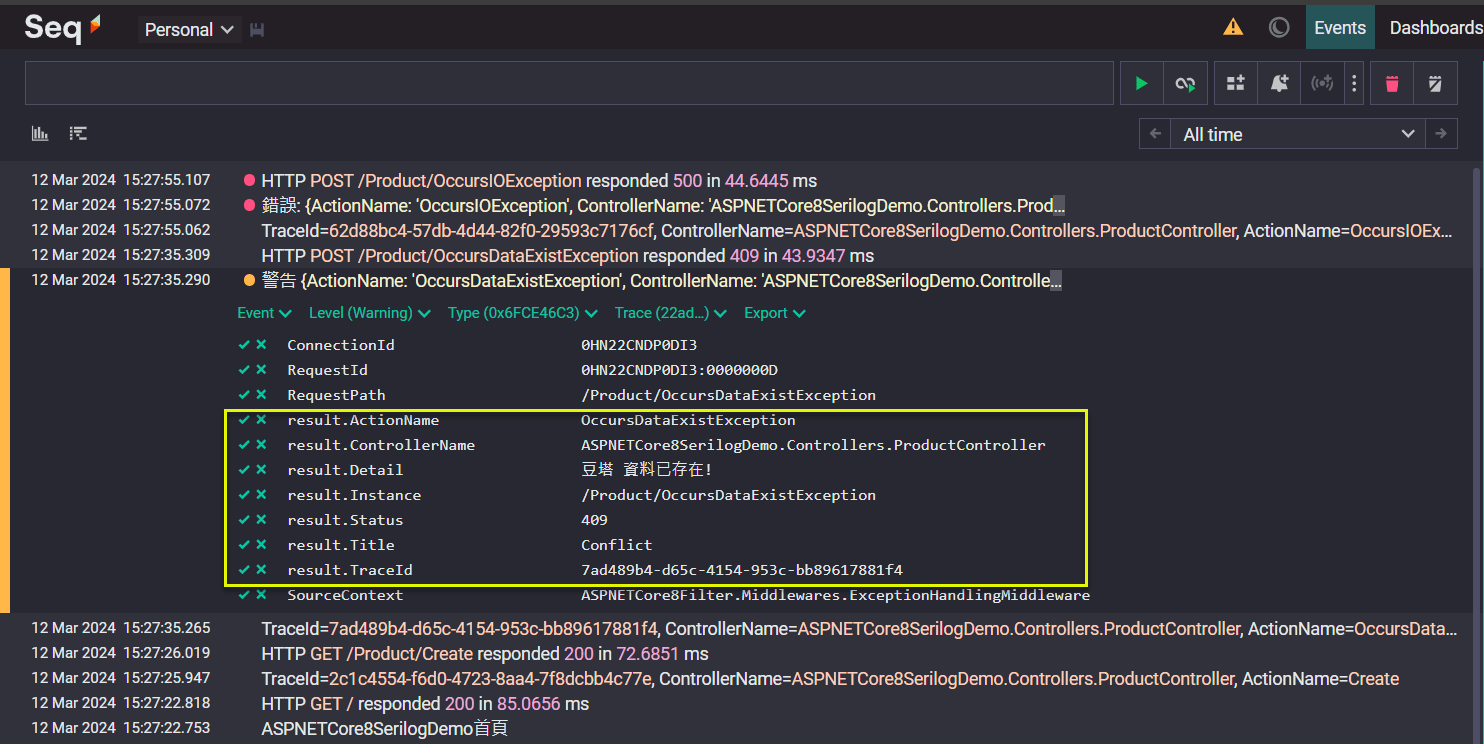
下圖是 _logger.LogError(exception, "錯誤: {@result}", result); 的結果.
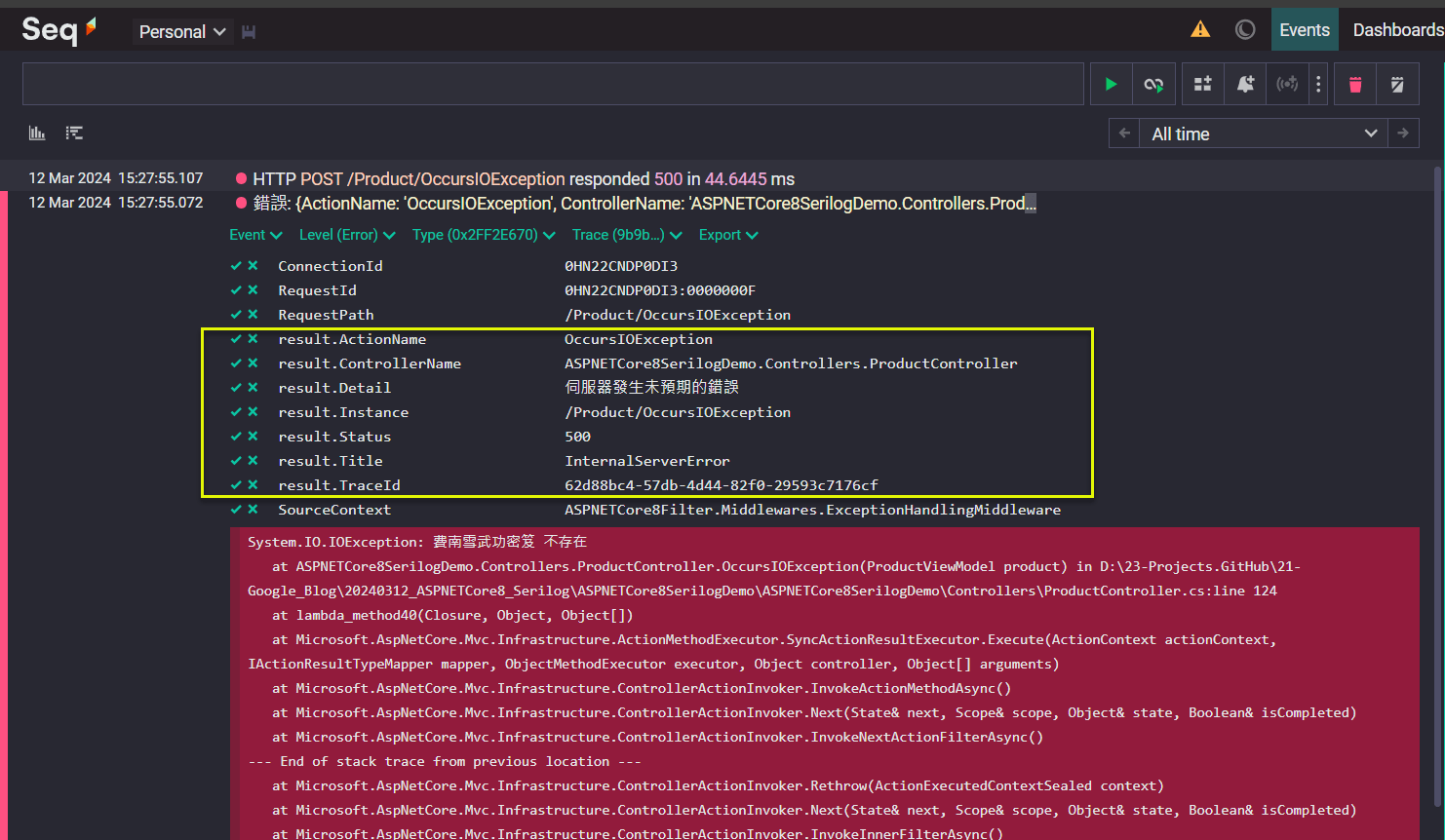
(5) 如果直接把 response 物件 (其型別為 ProblemDetails) 輸出至 Log 的話, 會變成這個狀況.
程式碼:
if (response.Status >= 400 && response.Status < 500)
_logger.LogWarning("警告 {@result}", response);
if (response.Status >= 500)
_logger.LogError(exception, "錯誤: {@result}", response);
執行結果:
- Console:
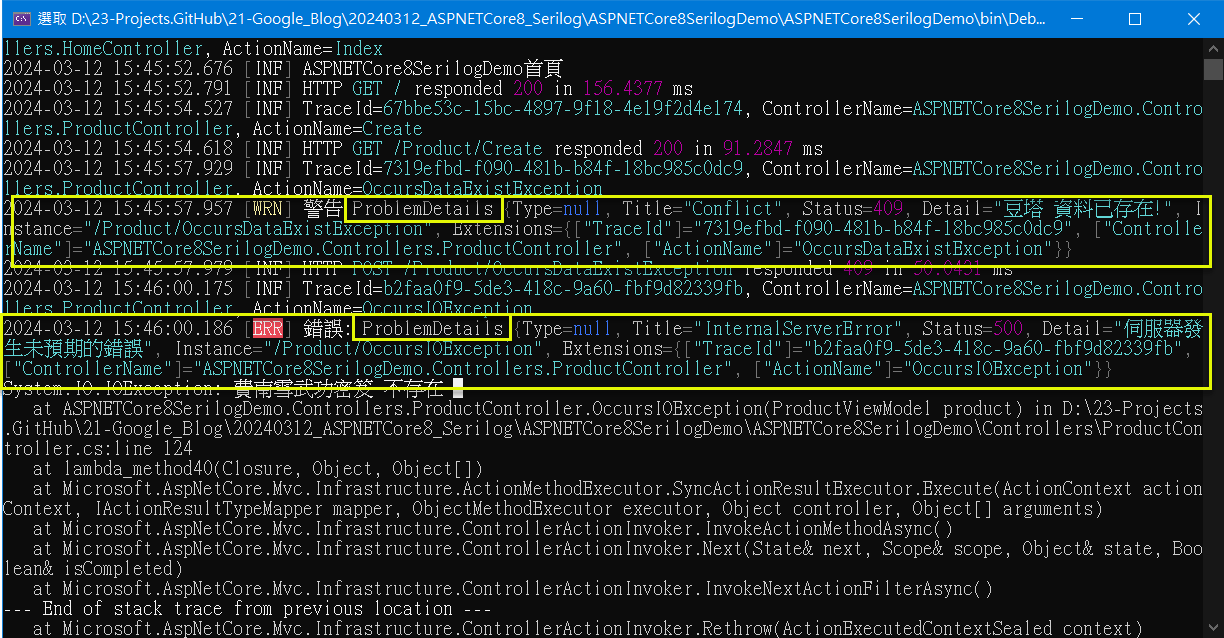
- Seq:
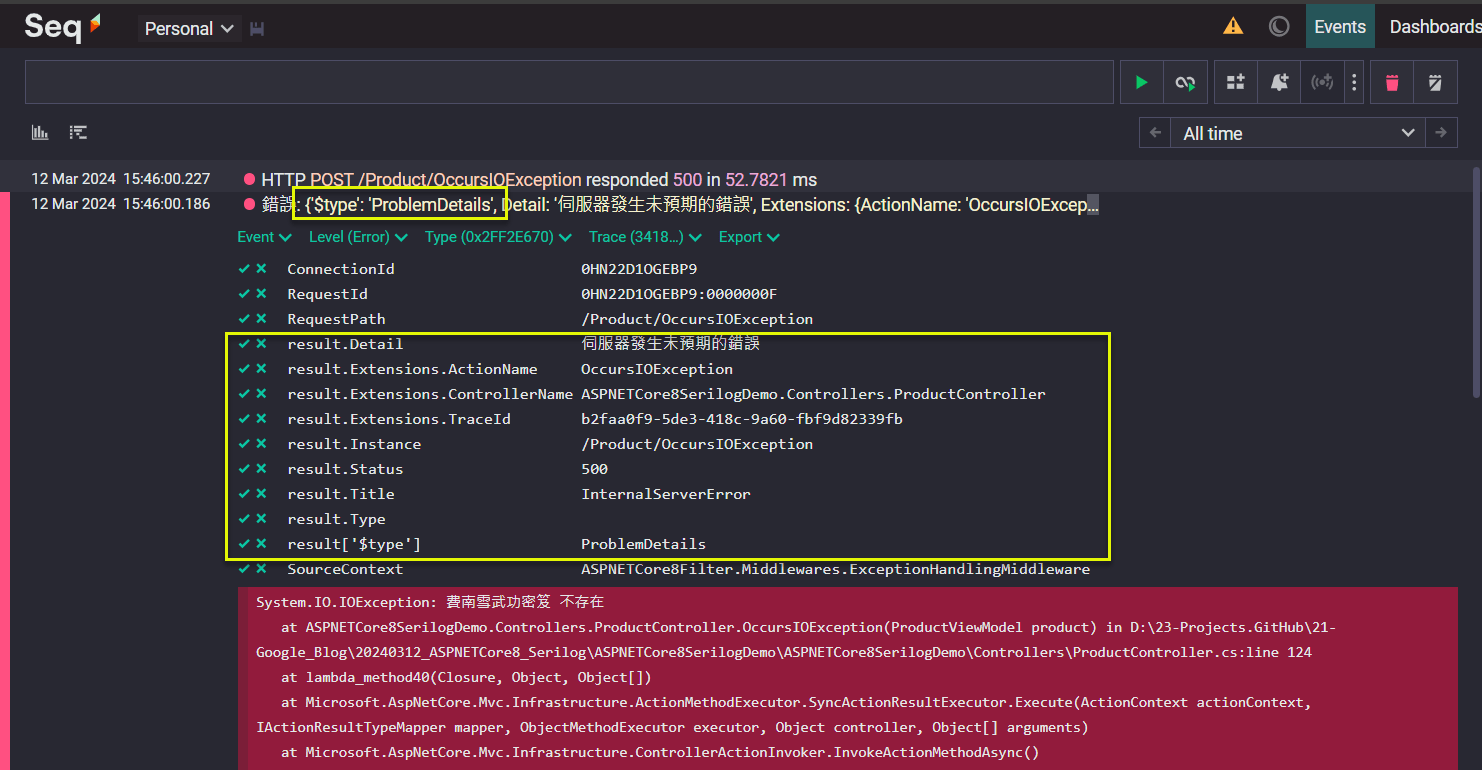
七. 輸出至 MSSQL 資料庫入門
其實最常見的需求是將 Log 輸出至資料庫, 然後再撰寫查詢程式, 供查詢之用.
以下將以寫入至 MSSQL 作說明.
(一) 套件安裝
安裝 Serilog.Sinks.MSSqlServer 套件.
(二) 由 Serilog.Sinks.MSSqlServer 決定預設的欄位及資料型態 (by appsettings.json)
修改 appsettings.json, 加入輸出至 MSSQL 的設置.
參考 (GitHub) serilog-sinks-mssqlserver 的 README.md 的說明.
不論是用程式或 appsettings.json 作設置, 會包含以下參數. 其中, 最重要的是以下 3 個.
- connectionString: 資料庫的連接字串.
- sinkOptions: Log Table 名稱及是否自動建立.
- columnOptions: Log Table 的欄位定義.
{
"Name": "MSSqlServer",
"Args": {
"connectionString": "Server=.\\SQL2016;Database=Cookies;Persist Security Info=False;Trusted_Connection=True;Encrypt=True;TrustServerCertificate=True;",
"schemaName": "dbo",
"tableName": "Logs",
"autoCreateSqlTable": true
}
}
如果只作以上設定的話, 會建立一個名稱為 Logs 的 Table, 包含以下欄位.
CREATE TABLE [dbo].[Logs] (
[Id] [int] IDENTITY(1,1) NOT NULL,
[Message] [nvarchar](max) NULL,
[MessageTemplate] [nvarchar](max) NULL,
[Level] [nvarchar](max) NULL,
[TimeStamp] [datetime] NULL,
[Exception] [nvarchar](max) NULL,
[Properties] [nvarchar](max) NULL,
CONSTRAINT [PK_Logs] PRIMARY KEY CLUSTERED ( [Id] ASC )
);
GO
小試一下:
(1) table:Logs 會自動被建立.
(2) 相關的資料會寫寫到 table:Logs.
(3) Properties 欄位內容是 Xml 的格式.

<properties>
<property key='SourceContext'>ASPNETCore8SerilogDemo.Controllers.HomeController</property>
<property key='ActionId'>3e479b65-ecf8-49fa-91c4-ed69dbdf02ee</property>
<property key='ActionName'>ASPNETCore8SerilogDemo.Controllers.HomeController.Index (ASPNETCore8SerilogDemo)</property>
<property key='RequestId'>0HN23Q28LEMFK:00000001</property>
<property key='RequestPath'>/</property>
<property key='ConnectionId'>0HN23Q28LEMFK</property>
</properties>
(三) Serilog.Sinks.MSSqlServer 欄位種類概述
1.. 標準欄位: (也就是前述 table:Logs)
以下是為了寫到資料庫用的.
- Id // The optional primary key
- Message // The message rendered with the template given the properties associated with the event
- MessageTemplate // The message template describing the event.
- Level // The level of the event.
- TimeStamp // The time at which the event occurred.
- Exception // An exception associated with the event, or null.
- Properties // Properties associated with the event, including those presented in Serilog.Sinks.MSSqlServer.StandardColumn.MessageTemplate.
以下是為了相容於舊版用的 (backwards-compatibility).
- TraceId // The OpenTelemetry trace id of the event.
- SpanId // The OpenTelemetry span id of the event.
- LogEvent // A log event.
如果要存入資料庫的話, 可以這樣作.
// we don't need XML data
columnOptions.Store.Remove(StandardColumn.Properties);
// we do want JSON data and OpenTelemetry
columnOptions.Store.Add(StandardColumn.LogEvent);
columnOptions.Store.Add(StandardColumn.TraceId);
columnOptions.Store.Add(StandardColumn.SpanId);
2.. 額外欄位: (AdditionalColumns)
因應需求, 而額外添加的欄位.
var columnOptions = new ColumnOptions
{
AdditionalColumns = new Collection<SqlColumn>
{
new SqlColumn
{ColumnName = "EnvironmentUserName", PropertyName = "UserName", DataType = SqlDbType.NVarChar, DataLength = 64},
new SqlColumn
{ColumnName = "UserId", DataType = SqlDbType.BigInt, NonClusteredIndex = true},
new SqlColumn
{ColumnName = "RequestUri", DataType = SqlDbType.NVarChar, DataLength = -1, AllowNull = false},
}
};
(四) 自訂 Serilog.Sinks.MSSqlServer 的欄位及資料型態 (by Program.cs)
如果想要移掉一些預設的欄位, 或者調整欄位長度, 要怎麼作呢?
由於用 appsettings.json 並不是那麼明顯, 改用 Program.cs 客製可能會比較容易撰寫.
1.. 修改 appsettings.json 的設定:
{
"ConnectionStrings": {
// Serilog.Sinks.MSSqlServer 連接字串
"SerilogConnectionString": "Server=.\\SQL2016;Database=Cookies;Persist Security Info=False;Trusted_Connection=True;Encrypt=True;TrustServerCertificate=True;"
},
"Serilog": {
"MinimumLevel": {
"Default": "Information",
"Override": {
"Microsoft.AspNetCore": "Warning"
}
},
"Enrich": [ "FromLogContext" ],
"WriteTo": [
{
"Name": "Console",
"Args": {
"outputTemplate": "{Timestamp:yyyy-MM-dd HH:mm:ss.fff} [{Level:u3}] {Message:l}{NewLine}{Exception}"
}
},
{
"Name": "File",
"Args": {
"path": "./logs/log-.txt",
"rollingInterval": "Day",
"formatter": "Serilog.Formatting.Compact.CompactJsonFormatter, Serilog.Formatting.Compact"
}
}
// 以下是原本寫在 appsettings.json 的 Serilog.Sinks.MSSqlServer 設定
//,
//{
// "Name": "MSSqlServer",
// "Args": {
// "connectionString": "Server=.\\SQL2016;Database=Cookies;Persist Security Info=False;Trusted_Connection=True;Encrypt=True;TrustServerCertificate=True;",
// "schemaName": "dbo",
// "tableName": "Logs",
// "autoCreateSqlTable": true
// }
//}
]
},
"AllowedHosts": "*"
}
2.. 修改 Program.cs:
#region 取得連接字串
var configuration = builder.Configuration;
var serilogConnectionString = configuration["ConnectionStrings:SerilogConnectionString"]?.ToString() ?? string.Empty;
#endregion
#region Serilog 的設置及使用
// ### for Seq + MSSQL (by hard coding)
// 目標:
// (1) 保留 Properties 的 SourceContext 欄位
// (2) 移除 MessageTemplate, Properties 這 2 個標準欄位
// (1) 保留 Properties 的 SourceContext 欄位
var columnOptions = new ColumnOptions
{
AdditionalColumns = new Collection<SqlColumn>
{
new() {
ColumnName = "SourceContext",
DataType = SqlDbType.NVarChar,
DataLength = 512,
AllowNull = true,
PropertyName = "SourceContext", // Match the property key in the log event
NonClusteredIndex = true
}
}
};
// (2) 移除 MessageTemplate, Properties 這 2 個標準欄位
columnOptions.Store.Remove(StandardColumn.Properties);
columnOptions.Store.Remove(StandardColumn.MessageTemplate);
Log.Logger = new LoggerConfiguration()
.ReadFrom.Configuration(builder.Configuration)
.WriteTo.Seq("http://localhost:5341")
.WriteTo.MSSqlServer(
connectionString: serilogConnectionString,
sinkOptions: new MSSqlServerSinkOptions
{
AutoCreateSqlTable = true,
SchemaName = "dbo",
TableName = "Logs"
},
columnOptions: columnOptions
)
.CreateLogger();
builder.Host.UseSerilog();
#endregion
3.. 小試一下:
(1) 建立的 table 欄位
CREATE TABLE [dbo].[Logs] (
[Id] [int] IDENTITY(1,1) NOT NULL,
[Message] [nvarchar](max) NULL,
[Level] [nvarchar](max) NULL,
[TimeStamp] [datetime] NULL,
[Exception] [nvarchar](max) NULL,
[SourceContext] [nvarchar](512) NULL,
CONSTRAINT [PK_Logs] PRIMARY KEY CLUSTERED ( [Id] ASC )
);
GO
(2) 執行結果:
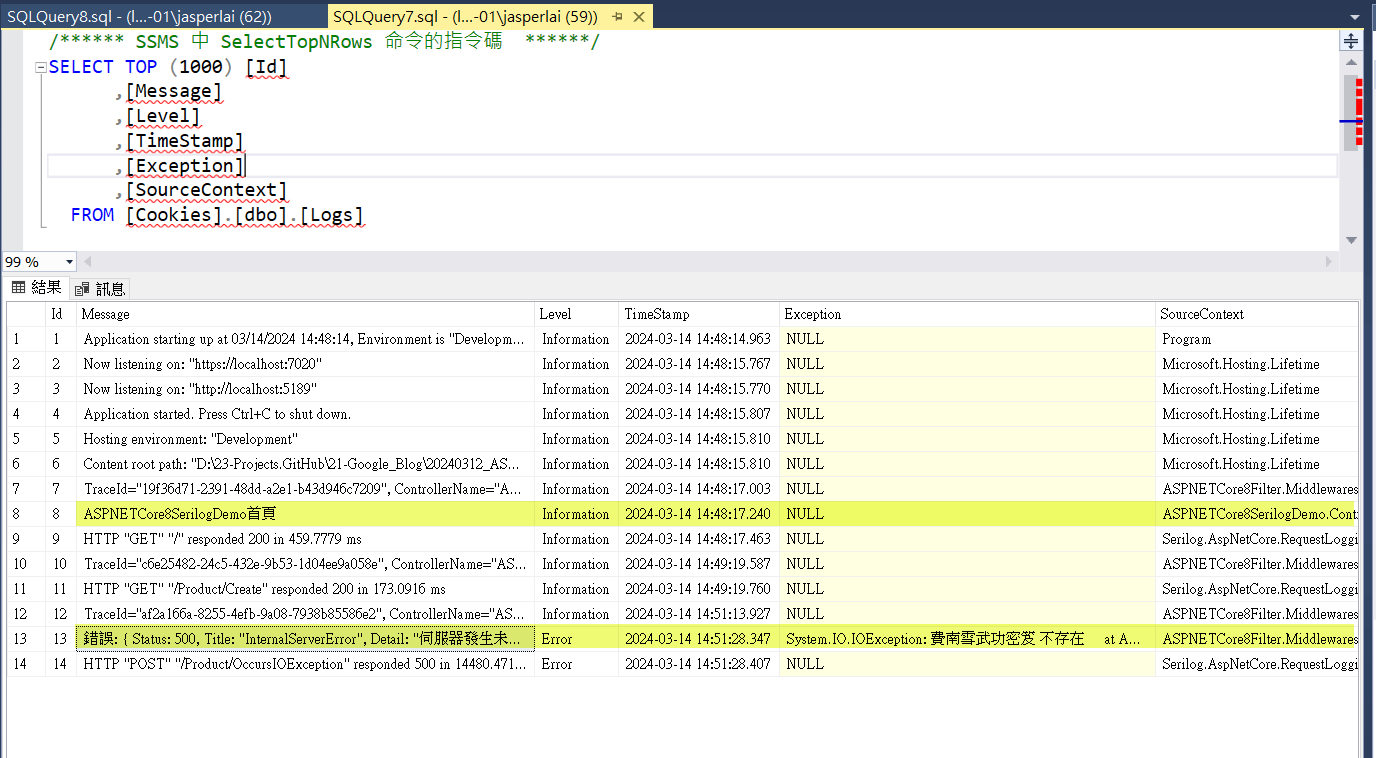
(五) 自訂 Serilog.Sinks.MSSqlServer 的欄位及資料型態 (for ProblemDetails by Program.cs)
1.. 修改 Program.cs:
將資料庫欄位對應至 Model Property.
請注意: 如果是用解構子的話, 必須在對應的 Model Property, 加上 {@placeHolder} 那個 placeHolder 作為前綴.
// ### for Seq + MSSQL (by hard coding)
// 目標:
// (1) 保留 Properties 的 SourceContext 欄位
// (2) 移除 MessageTemplate 這個標準欄位
// (3) 加入 ProblemDetails 的相關欄位
// (1) 保留 Properties 的 SourceContext 欄位
// (3) 加入 ProblemDetails 的相關欄位
var columnOptions = new ColumnOptions
{
AdditionalColumns = new Collection<SqlColumn>
{
new() { ColumnName = "SourceContext", DataType = SqlDbType.NVarChar, DataLength = 512, AllowNull = true, PropertyName = "SourceContext" },
new() { ColumnName = "Title", DataType = SqlDbType.NVarChar, DataLength = 50, AllowNull = true, PropertyName = "result.Title" },
new() { ColumnName = "Status", DataType = SqlDbType.Int, AllowNull = true, PropertyName = "result.Status" },
new() { ColumnName = "Detail", DataType = SqlDbType.NVarChar, DataLength = 512, AllowNull = true, PropertyName = "result.Detail" },
new() { ColumnName = "Instance", DataType = SqlDbType.NVarChar, DataLength = 512, AllowNull = true, PropertyName = "result.Instance" },
new() { ColumnName = "TraceId", DataType = SqlDbType.NVarChar, DataLength = 128, AllowNull = true, PropertyName = "result.TraceId" },
new() { ColumnName = "ControllerName", DataType = SqlDbType.NVarChar, DataLength = 256, AllowNull = true, PropertyName = "result.ControllerName" },
new() { ColumnName = "ActionName", DataType = SqlDbType.NVarChar, DataLength = 256, AllowNull = true, PropertyName = "result.ActionName" }
//new() { ColumnName = "Exception", DataType = SqlDbType.NVarChar, DataLength = -1, AllowNull = true } // -1 for max
}
};
// (2) 移除 MessageTemplate 這個標準欄位
//columnOptions.Store.Remove(StandardColumn.Properties);
columnOptions.Store.Remove(StandardColumn.MessageTemplate);
Log.Logger = new LoggerConfiguration()
.ReadFrom.Configuration(builder.Configuration)
.WriteTo.Seq("http://localhost:5341")
.WriteTo.MSSqlServer(
connectionString: serilogConnectionString,
sinkOptions: new MSSqlServerSinkOptions
{
AutoCreateSqlTable = true,
SchemaName = "dbo",
TableName = "Logs"
},
columnOptions: columnOptions
)
.CreateLogger();
builder.Host.UseSerilog();
2.. 小試一下:
(1) 建立的 table 欄位:
CREATE TABLE [dbo].[Logs] (
[Id] [int] IDENTITY(1,1) NOT NULL,
[Message] [nvarchar](max) NULL,
[Level] [nvarchar](max) NULL,
[TimeStamp] [datetime] NULL,
[Exception] [nvarchar](max) NULL,
[Properties] [nvarchar](max) NULL,
[SourceContext] [nvarchar](512) NULL,
[Title] [nvarchar](50) NULL,
[Status] [int] NULL,
[Detail] [nvarchar](512) NULL,
[Instance] [nvarchar](512) NULL,
[TraceId] [nvarchar](128) NULL,
[ControllerName] [nvarchar](256) NULL,
[ActionName] [nvarchar](256) NULL,
CONSTRAINT [PK_Logs] PRIMARY KEY CLUSTERED ( [Id] ASC )
);
GO
(2) 執行結果:
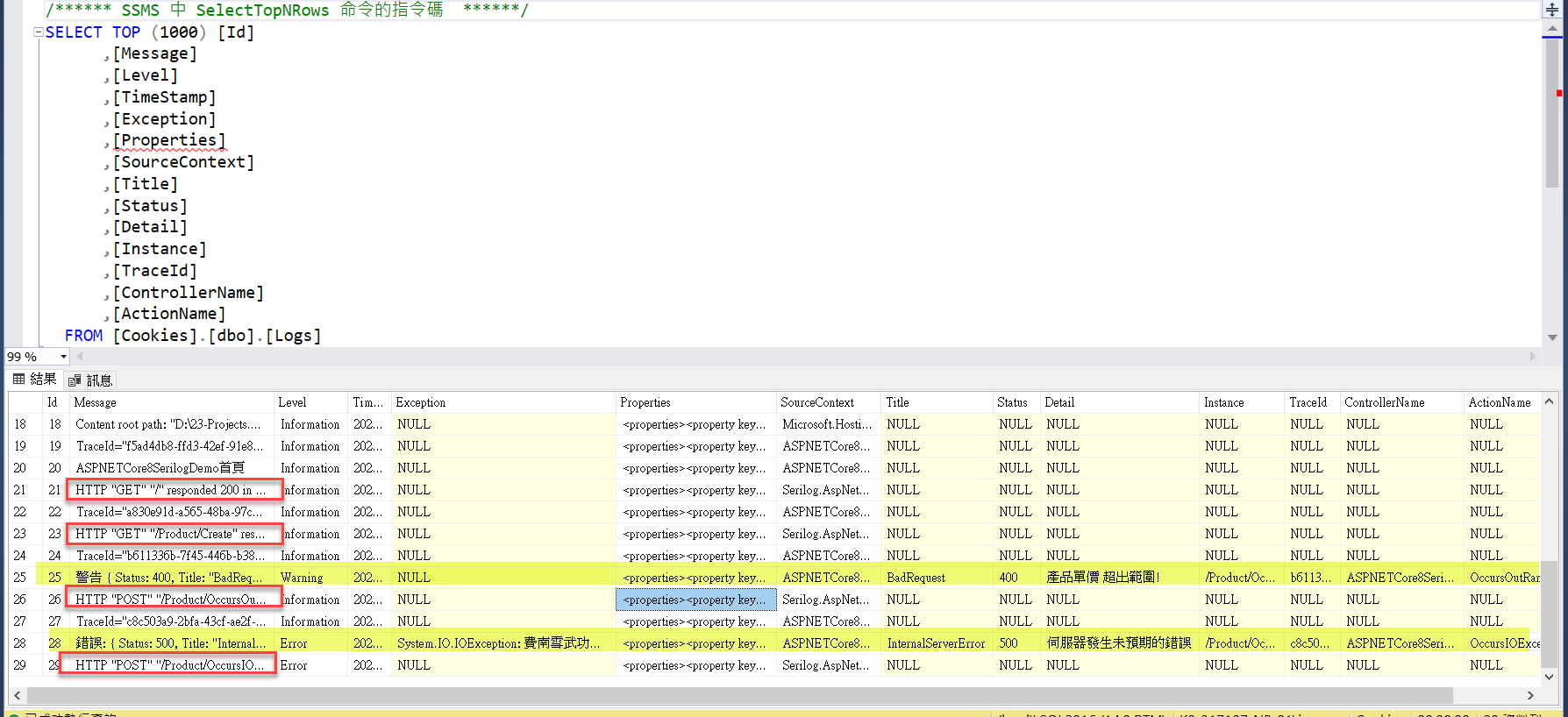
3.. 不想看到那麼多的日誌記錄, 要怎麼作?
如果不需要記錄每次的 request / response 之間的執行時間, 可以把 UseSerilogRequestLogging() 這段作 remark, 執行結果截圖如下.
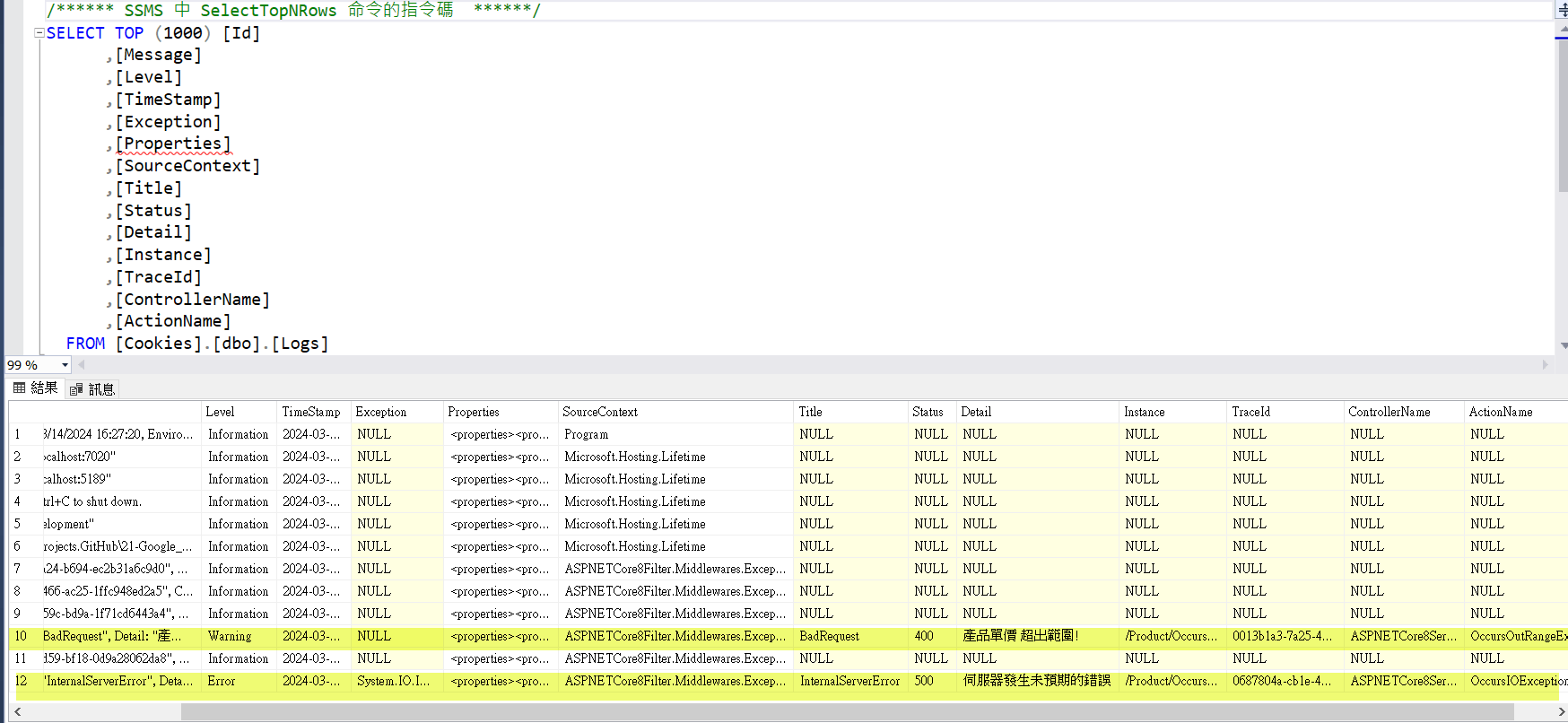
4.. 如果要對 table:Logs 的 Properties 作查詢, 要如何作?
Properties 欄位的內容是 Xml 格式, 查詢時要多費一些功夫.
Properties 資料內容範例:
<properties>
<property key='SourceContext'>ASPNETCore8SerilogDemo.Controllers.HomeController</property>
<property key='ActionId'>a7b4198c-7254-45a9-9ee8-c3e4b49dcbb9</property>
<property key='ActionName'>ASPNETCore8SerilogDemo.Controllers.HomeController.Index (ASPNETCore8SerilogDemo)</property>
<property key='RequestId'>0HN2405MHU0LL:00000001</property>
<property key='RequestPath'>/</property>
<property key='ConnectionId'>0HN2405MHU0LL</property>
</properties>
SQL 查詢指令:
SELECT A.*
FROM [Logs] A
WHERE CAST(A.Properties AS xml).value('(/properties/property[@key="RequestId"]/text())[1]', 'nvarchar(max)') = '0HN2405MHU0LL:00000001';
說明:
- /properties: 這個部分表示從 XML 根元素開始. 在 XML 結構中, 根元素是 <properties>.
- /property: 這代表在 <properties> 元素內部進一步巡覽至每個 <property> 子元素.
- [@key="RequestId"]: 這是一個條件表達式, 用於篩選具有特定屬性值的元素. 在這個例子中, 它過滿足條件 @key="RequestId" 的 <property> 元素, 即其 key 屬性的值為 "RequestId".
註: Refers to finding XML elements by name and attributes. - /text(): 這個函數用來選擇符合上述條件的元素的資料內容.
註: Refers to accessing the actual textual content within those selected elements. - [1]:因為 XPath 表達式可能返回一個節點的集合. 即使你只期望一個結果. 這個 [1] 是一個索引, 用來從可能的節點集中選取第一個節點.
(六) 改用自定義的統一輸出格式 (MyProblemDetails)
由於 System.Text.Json 及 Newtonsoft.Json 對於 ProblemDetails 的 Extensions 欄位有不同的序列化方式; 前者會打平, 後者會將在 Extensions 增加的欄位, 多加一層 Extensions 的節點. 故建立一個繼承自 ProblemDetails 的類別, 把增加的欄位, 全部打平, 後續前端在作處理時, 會方便許多.
public class MyProblemDetails : ProblemDetails
{
/// <summary>
/// Http Request 的追蹤代號 (GUID)
/// </summary>
public string? TraceId { get; set; } = string.Empty;
/// <summary>
/// Controller 全名
/// </summary>
public string? ControllerName { get; set; } = string.Empty;
/// <summary>
/// Action 名稱
/// </summary>
public string? ActionName { get; set; } = string.Empty;
/// <summary>
/// 使用者代碼
/// </summary>
public string? UserId { get; set; } = string.Empty;
}
(七) 建立一層 LoggingService<T> 打包 ILogger<T>, 以利寫入資料庫欄位
各位如果有細看先前資料庫輸出的內容, 可以發現有些 Log 記錄沒有寫入 table:Logs 的 TraceId, ControllerName, ActionName, Instance 欄位. 這是因為沒有用 {@placeHolder} 的方式去定義輸出欄位, 所以對應不上, 例如:
_logger.LogInformation("ASPNETCore8SerilogDemo首頁");
因此, 筆者定義了一層 LoggingService<T> 將 Microsoft.Extensions.Logging.LoggerExtensions 靜態類別 的 LogInformation, LogWarning, LogError 等方法, 重新包裝一層, 主動補上 MyProblemDetails 的欄位內容, 這樣上述 table:Logs 的欄位, 就會有資料內容了.
有興趣的朋友, 可自行參考程式內容.
另外, 關於 @ 解構子的作用, 可以看一下 "產品清單" 那個功能的 Console 輸出.
1.. 採用 _logger.LogInformation().
_logger.LogInformation("產品清單(_logger): {myId} {products}", "001", products);
_logger.LogInformation("產品清單(_logger): {@myId} {@products}", "002", products);
(1) 不加 @ 解構子: 只會出現 ProductViewModel 這個 class name
2024-03-16 20:24:46.452 [INF] 產品清單(_logger): 001 ["ASPNETCore8SerilogDemo.Models.ProductViewModel", "ASPNETCore8SerilogDemo.Models.ProductViewModel"]
(2) 有加 @ 解構子: 除了出現 ProductViewModel 這個 class name 之外, 還包括其內容.
2024-03-16 20:24:46.459 [INF] 產品清單(_logger): 002 [ProductViewModel {Id=1, Name="布丁", OrderQty=1, UnitPrice=50}, ProductViewModel {Id=2, Name="蛋塔", OrderQty=1, UnitPrice=40}]
2.. 採用 _loggingService.LogInformation().
_loggingService.LogInformation("產品清單(_loggingService): {products}", products);
_loggingService.LogInformation("產品清單(_loggingService): {@products}", products);
(1) 不加 @ 解構子: 因為 LoggingService, 會主動改成 {@structuredData} 作為解構子, 除了出現 ProductViewModel 這個 class name 之外, 還包括其內容.
2024-03-16 20:24:46.474 [INF] 產品清單(_loggingService): {products}: [ProductViewModel {Id=1, Name="布丁", OrderQty=1, UnitPrice=50}, ProductViewModel {Id=2, Name="蛋塔", OrderQty=1, UnitPrice=40}]: MyProblemDetails {TraceId="a6184631-8818-41f7-beda-d959559dce37", ControllerName="ASPNETCore8SerilogDemo.Controllers.ProductController", ActionName="Index", UserId="jasper", Type=null, Title="OK", Status=200, Detail="", Instance="/Product", Extensions={}}
(2) 有加 @ 解構子: 除了出現 ProductViewModel 這個 class name 之外, 還包括其內容.
2024-03-16 20:24:46.491 [INF] 產品清單(_loggingService): {@products}: [ProductViewModel {Id=1, Name="布丁", OrderQty=1, UnitPrice=50}, ProductViewModel {Id=2, Name="蛋塔", OrderQty=1, UnitPrice=40}]: MyProblemDetails {TraceId="a6184631-8818-41f7-beda-d959559dce37", ControllerName="ASPNETCore8SerilogDemo.Controllers.ProductController", ActionName="Index", UserId="jasper", Type=null, Title="OK", Status=200, Detail="", Instance="/Product", Extensions={}}
(3) 前述 2 者幾乎沒什麼差異, 但在 Seq 可以看得更清楚.
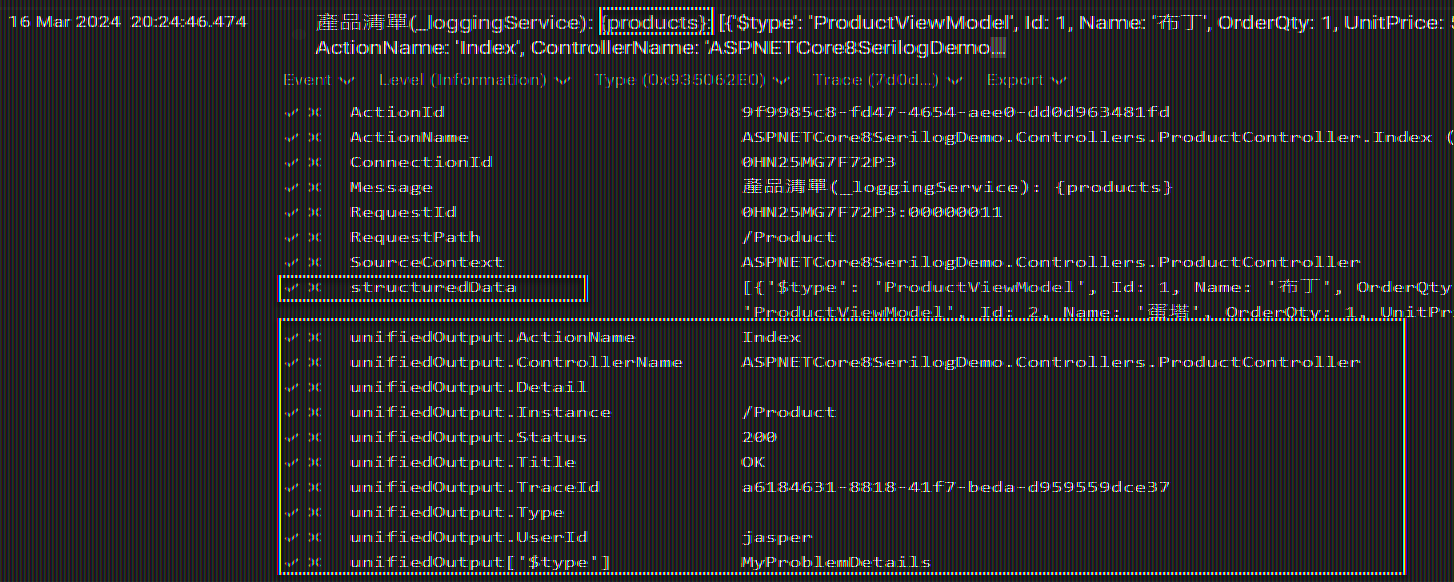
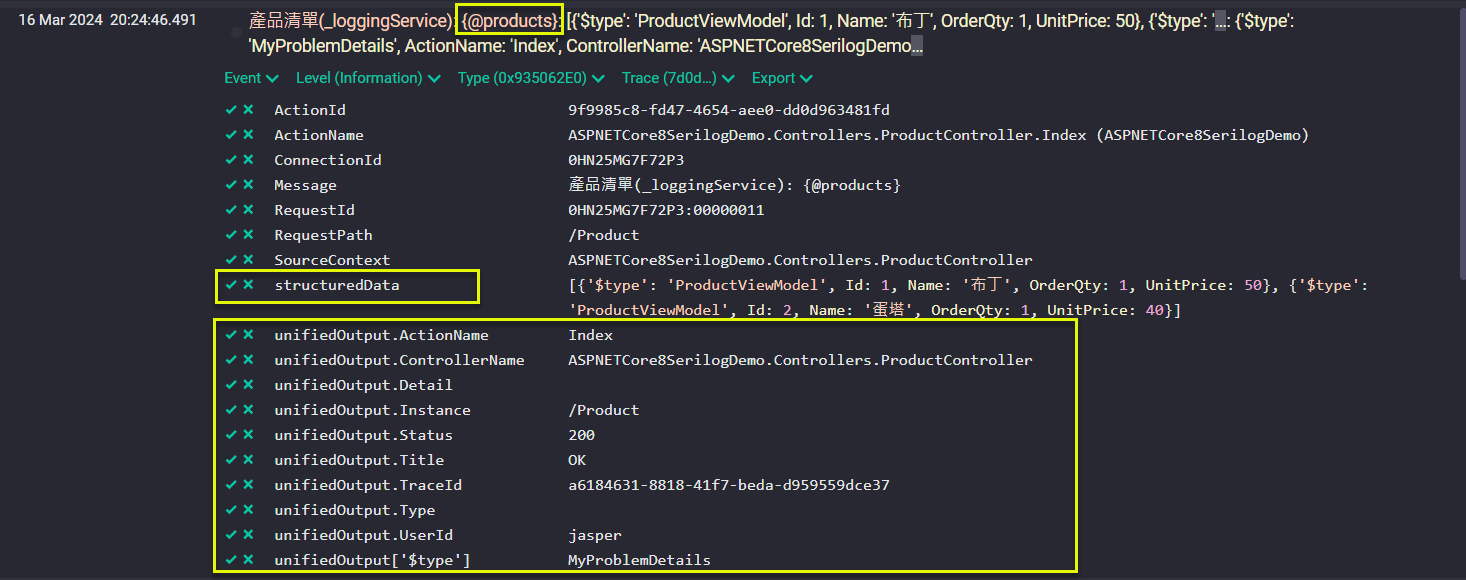
3.. 附上資料庫輸出的截圖.


八. 關於 Serilog 的增強器 (Enrichers)
(一) 簡介
Serilog 的增強功能允許在整個應用程序中系統地向Log記錄添加額外信息. 這些額外信息可以是任何有助於提供更多上下文的信息, 如應用程式版本、環境名稱或使用者代號.
可參考官網說明, 以下僅列出幾個現成的增強器.
- Serilog.Enrichers.Environment: WithMachineName() and WithEnvironmentUserName()
- 安裝以下套件: Serilog.Enrichers.Environment
- Serilog.Enrichers.Process: WithProcessId()
- 安裝以下套件: Serilog.Enrichers.Process
- Serilog.Enrichers.Thread: WithThreadId()
- 安裝以下套件: Serilog.Enrichers.Thread
(二) 使用內建的 Enricher
1.. 修改 Program.cs.
(1) 加入 Enrich.WithXXXX()
Log.Logger = new LoggerConfiguration()
.MinimumLevel.Information()
.MinimumLevel.Override("Microsoft.AspNetCore", LogEventLevel.Warning)
.Enrich.FromLogContext()
.Enrich.WithMachineName() // Adds the machine name
.Enrich.WithThreadId() // Adds the thread id
.Enrich.WithEnvironmentName() // Adds the environment name (e.g., Development, Product
.Enrich.WithProperty("Application", "SerilogEnricherDemo") // 加入自定義的屬性, 這個是全域的; 如果是用 PushProperty 的話, 則只限於某個 using 的區塊或整個 method
.WriteTo.Console(
outputTemplate: "{Timestamp:yyyy-MM-dd HH:mm:ss} [{Level:u3}] {Message:l} {Properties}{NewLine}{Exception}"
)
.WriteTo.File("logs/log-.txt", rollingInterval: RollingInterval.Day)
.WriteTo.Seq("http://localhost:5341")
.CreateLogger();
// 使用 Serilog
builder.Host.UseSerilog();
2.. 小試一下.
檢查 Console 的輸出, 可以看到每一筆 Log 記錄, 都有 MachineName="MyComputer01", ThreadId=1, EnvironmentName="Development", Application="SerilogEnricherDemo".
2024-03-19 17:07:48 [INF] Processed {Latitude=25, Longitude=134} in 34 ms {SourceContext="ASPNETCore8SerilogEnrich.Controllers.HomeController", ActionId="039ad7da-4fa8-495e-ba8c-6213bd744d16", ActionName="ASPNETCore8SerilogEnrich.Controllers.HomeController.Index (ASPNETCore8SerilogEnrich)", RequestId="0HN27UG63SI37:00000001", RequestPath="/", ConnectionId="0HN27UG63SI37", MachineName="MyComputer01", ThreadId=14, EnvironmentName="Development", Application="SerilogEnricherDemo"}
(三) 建立自定義的 Enrichers.
前面所述是內建或別人寫的 Enrichers, 要如何自己寫一個呢?
1.. 建立一個實作 ILogEventEnricher 的類別.
public class ReleaseNumberEnricher : ILogEventEnricher
{
LogEventProperty _cachedProperty = null!;
public const string PropertyName = "ReleaseNumber";
/// <summary>
/// Enrich the log event.
/// </summary>
/// <param name="logEvent">The log event to enrich.</param>
/// <param name="propertyFactory">Factory for creating new properties to add to the event.</param>
public void Enrich(LogEvent logEvent, ILogEventPropertyFactory propertyFactory)
{
logEvent.AddPropertyIfAbsent(GetLogEventProperty(propertyFactory));
}
private LogEventProperty GetLogEventProperty(ILogEventPropertyFactory propertyFactory)
{
// Don't care about thread-safety, in the worst case the field gets overwritten and one property will be GCed
if (_cachedProperty == null)
_cachedProperty = CreateProperty(propertyFactory);
return _cachedProperty;
}
private static LogEventProperty CreateProperty(ILogEventPropertyFactory propertyFactory)
{
var value = Environment.GetEnvironmentVariable("RELEASE_NUMBER") ?? "local";
return propertyFactory.CreateProperty(PropertyName, value);
}
}
2.. 建立一個擴充方法, 供 Program.cs 裡的 Enrich 叫用.
public static class LoggingExtensions
{
public static LoggerConfiguration WithReleaseNumber(
this LoggerEnrichmentConfiguration enrich)
{
ArgumentNullException.ThrowIfNull(enrich);
return enrich.With<ReleaseNumberEnricher>();
}
}
3.. 修改 Program.cs.
(1) 設定環境變數 RELEASE_NUMBER.
#region 設定環境變數 RELEASE_NUMBER, 供 WithReleaseNumber Enricher 使用.
Environment.SetEnvironmentVariable("RELEASE_NUMBER", "1.0.0");
#endregion
(2) 加入 .Enrich.WithReleaseNumber()
Log.Logger = new LoggerConfiguration()
.MinimumLevel.Information()
.MinimumLevel.Override("Microsoft.AspNetCore", LogEventLevel.Warning)
.Enrich.FromLogContext()
.Enrich.WithMachineName() // Adds the machine name
.Enrich.WithThreadId() // Adds the thread id
.Enrich.WithEnvironmentName() // Adds the environment name (e.g., Development, Product
// 加入自定義的屬性, 這個是全域的; 如果是用 PushProperty 的話, 則只限於某個 using 的區塊或整個 method
.Enrich.WithProperty("Application", "SerilogEnricherDemo")
.Enrich.WithReleaseNumber()
.WriteTo.Console(
outputTemplate: "{Timestamp:yyyy-MM-dd HH:mm:ss} [{Level:u3}] {Message:l} {Properties}{NewLine}{Exception}"
)
.WriteTo.File("logs/log-.txt", rollingInterval: RollingInterval.Day)
.WriteTo.Seq("http://localhost:5341")
.CreateLogger();
// 使用 Serilog
builder.Host.UseSerilog();
4.. 小試一下. 在 Console 上呈現的結果大致如下.
2024-03-19 17:18:27 [INF] Web Application 設置完成, 即將啟動... {MachineName="MyComputer01", ThreadId=1, EnvironmentName="Development", Application="SerilogEnricherDemo", ReleaseNumber="1.0.0"}
2024-03-19 17:18:27 [INF] 這是 Enrich 首頁 {SourceContext="ASPNETCore8SerilogEnrich.Controllers.HomeController", ActionId="5e8bc332-aa05-4d3c-ba3d-680d1db6884e", ActionName="ASPNETCore8SerilogEnrich.Controllers.HomeController.Index (ASPNETCore8SerilogEnrich)", RequestId="0HN27UM4M1L1P:00000001", RequestPath="/", ConnectionId="0HN27UM4M1L1P", MachineName="MyComputer01", ThreadId=9, EnvironmentName="Development", Application="SerilogEnricherDemo", ReleaseNumber="1.0.0"}
2024-03-19 17:18:27 [INF] Processed {Latitude=25, Longitude=134} in 34 ms {SourceContext="ASPNETCore8SerilogEnrich.Controllers.HomeController", ActionId="5e8bc332-aa05-4d3c-ba3d-680d1db6884e", ActionName="ASPNETCore8SerilogEnrich.Controllers.HomeController.Index (ASPNETCore8SerilogEnrich)", RequestId="0HN27UM4M1L1P:00000001", RequestPath="/", ConnectionId="0HN27UM4M1L1P", MachineName="MyComputer01", ThreadId=9, EnvironmentName="Development", Application="SerilogEnricherDemo", ReleaseNumber="1.0.0"}
結論
又是一篇花不少時間及心力的文章, 整個脈絡如下圖:
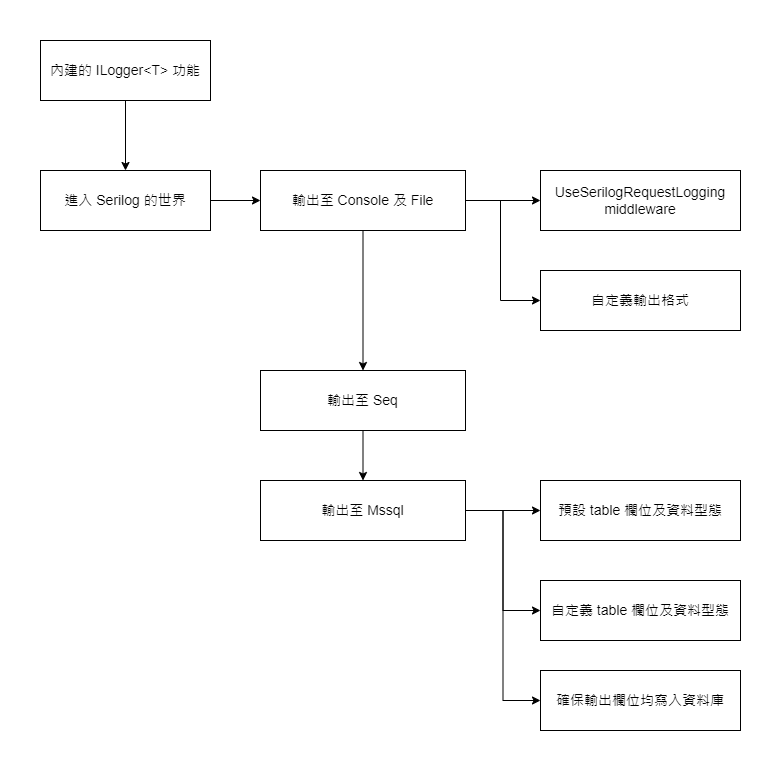
最大的瓶頸在於輸出至 Mssql 資料庫, 如果不需將 Log 記錄內容獨立為欄位, 其實只需預設建立的欄位即可 ([Id], [Message], [Level], [TimeStamp], [Exception], [Properties]). 只是 [Message] 及 [Properties] 欄位不容易以 SQL 查詢.
如果公司同意用 Seq 的話, 那是最方便不過的:
(1) 開發人員不用去想資料庫的 table 要放那些欄位.
(2) 開發人員不用去開發查詢 UI.
(3) 系統管理人員有現成方便 UI, 而且有方便的過濾條件可以使用.
原本想要試一下寫到 Oracle, 但發現 Serilog.Sinks.Oracle 最近的更新日期在 2020.04.24, 且沒有被列在 Provided Sinks for Serilog 清單裡, 看來要花更多時間去實證, 後續有空再試看看.
參考文件
(1) 透過 docker 執行 seq 的指令: docker run --name seq -d --restart unless-stopped -e ACCEPT_EULA=Y -p 5341:80 datalust/seq:latest
(2) 在瀏覽器網址列輸入: http://localhost:5341/ 就可以進入 seq 的 Web UI 介面.
(GitHub) Serilog 可用的記錄目標 (Log Sinks) 清單.
(GitHub) UseSerilogRequestLogging middleware 的使用說明.
訂閱方式總共有 4 個層級: Individual / Team / Enterprise / Datacenter. Individual 是免費的.
下圖所謂的使用者數, 係指 Web UI 可以登入的 User Id, 在 Individual 的狀況下, 預設是 admin.
The Individual license permits one person to access the Seq web interface. Seq installations configured with the Individual license can't be accessed by more than one person, regardless of whether or not login credentials are shared. If more than one person will use a Seq instance, a multi-user subscription is required.
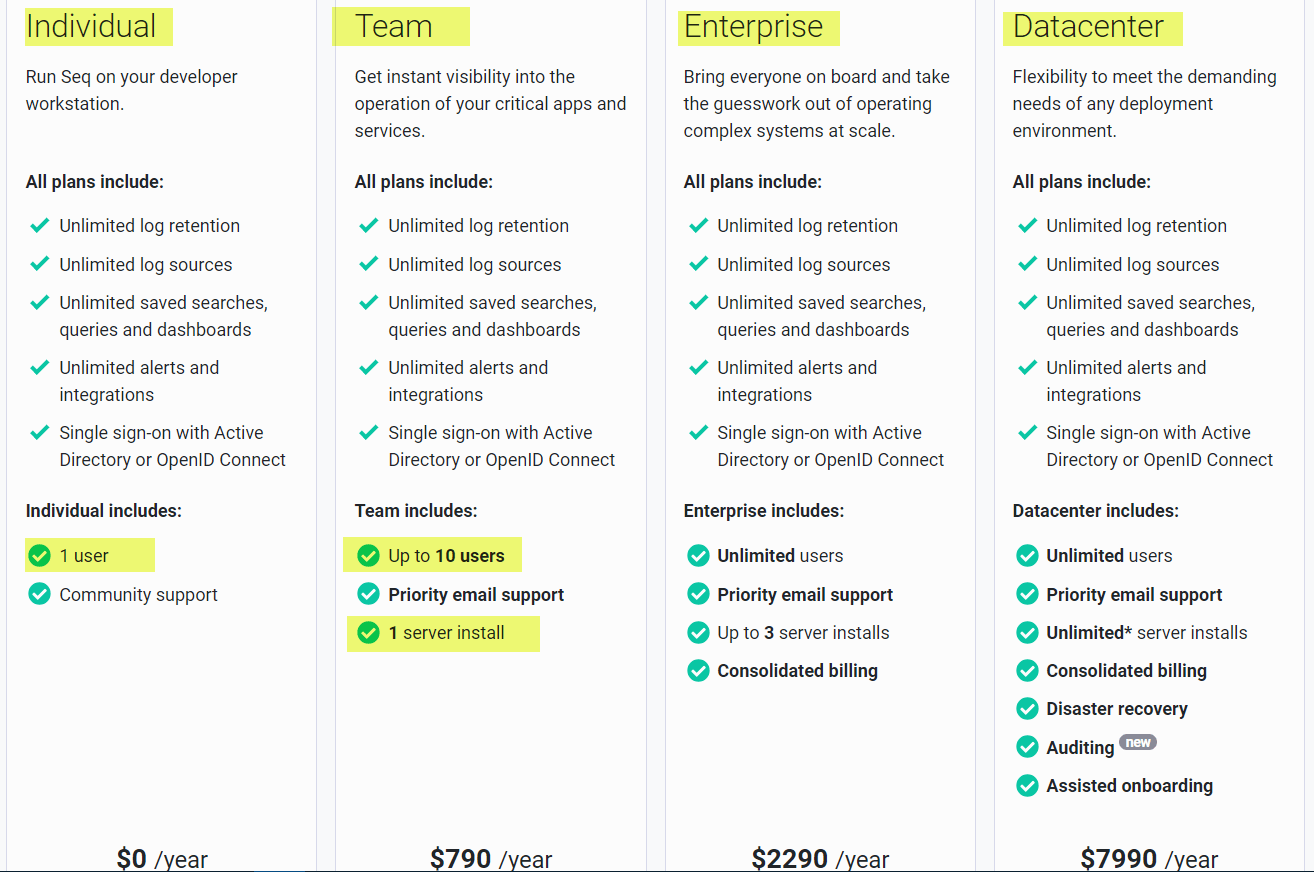
The Metastore: contains configuration data such as users, signals, dashboards, and so on. Native (embedded storage in the Documents/ subfolder under Seq's local storage root). This is the default option for Seq installs and doesn't rely on any external database or storage technologies.
The Event Store: contains the application log data that is searchable in the Seq UI. The event store persists data in the Stream/ directory under Seq's local storage root.
筆者補充(2024.03.25): 如何進入 container 查看相關的資料夾及檔案結構?
PS D:\Temp> docker exec -it seq bash
# cd /data
# ls -al
total 32
drwxr-xr-x 7 root root 4096 Mar 25 03:03 .
drwxr-xr-x 1 root root 4096 Mar 11 06:34 ..
drwxr-xr-x 2 root root 4096 Mar 25 03:03 Backups
drwxr-xr-x 2 root root 4096 Mar 25 02:23 Documents
drwxr-xr-x 2 root root 4096 Mar 11 06:34 Init
drwxr-xr-x 2 root root 4096 Mar 25 02:23 Logs
-rw-r--r-- 1 root root 2186 Mar 25 02:23 Seq.json
drwxr-xr-x 2 root root 4096 Mar 25 02:43 Stream
# ls -al Backups
total 20
drwxr-xr-x 2 root root 4096 Mar 25 03:03 .
drwxr-xr-x 7 root root 4096 Mar 25 03:03 ..
-rw-r--r-- 1 root root 9344 Mar 25 03:03 seq_20240325.seqbac
# ls -al Logs
total 568
drwxr-xr-x 2 root root 4096 Mar 25 02:23 .
drwxr-xr-x 7 root root 4096 Mar 25 03:03 ..
-rw-r--r-- 1 root root 81969 Mar 11 09:11 seq-20240311.log
-rw-r--r-- 1 root root 64982 Mar 12 09:06 seq-20240312.log
-rw-r--r-- 1 root root 33544 Mar 14 09:16 seq-20240314.log
-rw-r--r-- 1 root root 50795 Mar 15 09:13 seq-20240315.log
-rw-r--r-- 1 root root 80574 Mar 16 13:39 seq-20240316.log
-rw-r--r-- 1 root root 6943 Mar 17 02:53 seq-20240317.log
-rw-r--r-- 1 root root 189137 Mar 19 09:26 seq-20240319.log
-rw-r--r-- 1 root root 19531 Mar 25 03:08 seq-20240325.log
# ls -al Documents
total 100
drwxr-xr-x 2 root root 4096 Mar 25 02:23 .
drwxr-xr-x 7 root root 4096 Mar 25 03:03 ..
-rw-r--r-- 1 root root 782 Mar 25 02:23 metastore.2.metadata
-rw-r--r-- 1 root root 8 Mar 11 06:34 metastore.collection.561b552d29b849fea3a926001b28d507.docc
-rw-r--r-- 1 root root 80322 Mar 25 02:36 metastore.collection.c4f86f07cff148209386011ea284a0d7.docc
-rw-r--r-- 1 root root 8 Mar 11 06:34 metastore.flare
# ls -al Stream
total 128
drwxr-xr-x 2 root root 4096 Mar 25 02:43 .
drwxr-xr-x 7 root root 4096 Mar 25 03:03 ..
-rw-r--r-- 1 root root 543 Mar 25 02:43 stream.08dc458cd7eae000_08dc47e7ebde4e00.ed3041b2faf247ada4dbd6f08c3d4fcb.index
-rw-r--r-- 1 root root 47171 Mar 25 02:33 stream.08dc458cd7eae000_08dc47e7ebde4e00.fb8790661cbd4816b852841a57a5d44c.span
-rw-r--r-- 1 root root 277 Mar 25 02:43 stream.08dc47ee7cb82800_08dc47f58abd7700.4a3d1e88929549c3a30806512520285a.index
-rw-r--r-- 1 root root 26239 Mar 25 02:33 stream.08dc47ee7cb82800_08dc47f58abd7700.6c237a69c55a4ea0b5beea53449303d4.span
-rw-r--r-- 1 root root 5140 Mar 25 02:30 stream.08dc4c73781ec400.899cf442a7f442c18f6c9ffdea4f28d9.tick
-rw-r--r-- 1 root root 1624 Mar 25 02:34 stream.08dc4c74072bdc00.aeb40580f55c433b93f01dc6afd35514.tick
-rw-r--r-- 1 root root 2377 Mar 25 02:35 stream.08dc4c743cd0c500.73c8fbd959b34f85b49980b7bed388bb.tick
-rw-r--r-- 1 root root 8538 Mar 25 02:43 stream.2.metadata
-rw-r--r-- 1 root root 973 Mar 11 06:44 stream.collection.d4b3bf22938947b3862d2b4f8b44c6ae.docc
-rw-r--r-- 1 root root 8 Mar 11 06:34 stream.flare
沒有留言:
張貼留言